What is a Mjolnir Pendant?
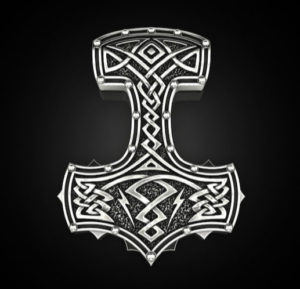
Image above shows a white gold pendant sold by the LoniDesignGroup store on etsy.com $482
Mjolnir pendants have been uncovered at countless archeological digs in Scandinavia and what is today called Germany along with the northern parts of what is today called France. The classic mjolnir symbol represents the hammer wielded by the old pre-Christian Nordic god named Thor. In pre-Christian times, the people of northern Europe often wore metal pendants that represented Thor’s hammer, and they wore these necklace pendants because Thor was believed to be the protector of farmers and Thor also represented internal strength and fortitude. Thor was additionally considered to be the perfect warrior that all men should seek to emulate, and Thor was considered to be the god who governed and watched after sacred groves of tree and all of Earth, or Midgard as Earth was known within old Norse mythology.
Old Norse mythology is replete with tales of Thor, his hammer called Mjolnir, and his chariot pulled by two goats. Thor was considered to be the son of the highest God named Odin, and he was husband to the goddess of fertility who was named Sif.
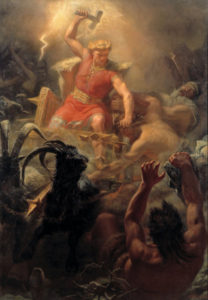
The classic painting of Thor is furnished courtesy of wikipedia.org The image above is a painting called Thor Fights With the Giants. The painting above was produced by Martin Eskil Winge.
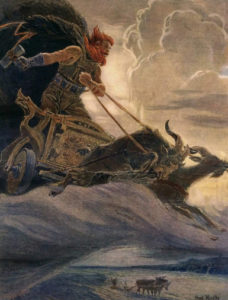
The image above is a copy of the painting called Donar-Thor by Max Koch which is furnished courtesy mythus.fandom.com
The excerpt below tells of how Thor’s hammer was made according to Norse mythology. The except cited below was copied from the norse-mythology.org website.
THE CREATION OF THOR’S HAMMER
One day, Loki the trickster found himself in an especially mischievous mood and cut off the gorgeous golden hair of Sif, the wife of Thor. When Thor learned of this, his quick temper was enraged, and he seized Loki and threatened to break every bone in his body. Loki pleaded with the thunder god to let him go down to Svartalfheim, the cavernous home of the dwarves, and see if those master craftspeople could fashion a new head of hair for Sif, this one even more beautiful than the original. Thor allowed this, and off Loki went to Svartalfheim.
Image of Loki cutting Sif’s hair furnished courtesy of germanicmythology.com
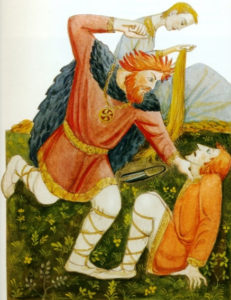
The painting of Thor threatening Loki was painted by Mikahil Fiodorov and appears on germanicmytholgoy.com
There he was able to obtain what he desired. The sons of the dwarf Ivaldi forged not only a new head of hair for Sif, but also two other marvels: Skidbladnir (“Assembled from Thin Pieces of Wood”[1]), the best of all ships, which always has a favorable wind and can be folded up and put into one’s pocket, and Gungnir (“Swaying”[2]), the deadliest of all spears.
Having accomplished his task, Loki was overcome by an urge to remain in the caves of the dwarves and revel in more recklessness. He approached the brothers Brokkr and Sindri (“Metalworker”[3] and “Spark-sprayer,”[5] respectively) and taunted them, saying that he was sure the brothers could never forge three new creations equal to those the sons of Ivaldi had fashioned. In fact, he even bet his head on their lack of ability. Brokkr and Sindri, however, accepted the wager.
As they worked, a fly (who, of course, was none other than Loki in disguise) stung Sindri’s hand. When the dwarf pulled his creation out of the fire, it was a living boar with golden hair. This was Gullinbursti (“Golden-bristled”), who gave off light in the dark and could run better than any horse, even through water or air.
Sindri then set another piece of gold on the fire as Brokkr worked the bellows. The fly bit Brokkr on the neck, and Sindri drew out a magnificent ring, Draupnir (“Dripper”[5]). From this ring, every ninth night, fall eight new golden rings of equal weight.
Sindri then put iron on the hearth, and told Brokkr that, for this next working, they must be especially meticulous, for a mistake would be more costly than with the previous two projects. Loki immediately stung Brokkr’s eyelid, and the blood blocked the dwarf’s eye, preventing him from properly seeing his work. Sindri produced a hammer of unsurpassed quality, which never missed its mark and would boomerang back to its owner after being thrown, but it had one flaw: the handle was short. Sindri lamented that this had almost ruined the piece, which was called Mjollnir (“Lightning”[6]). Nevertheless, sure of the great worth of their three treasures, Sindri and Brokkr made their way to Asgard to claim the wages that were due to them.
Loki made it to the halls of the gods before the dwarves and presented the marvels he had acquired. To Thor he gave Sif’s new hair and the hammer Mjollnir. To Odin went the ring Draupnir and the spear Gungnir. And Freyr was the happy recipient of Skidbladnir and Gullinbursti.
As grateful as the gods were to receive these gifts – especially Mjollnir, which they foresaw would be of inestimable help in their battles against the giants – they nevertheless concluded that Loki still owed the dwarves his head. When the dwarves approached Loki with knives, the cunning god pointed out that he had promised them his head, but not his neck. Brokkr and Sindri contented themselves with sewing Loki’s mouth shut, and returned to their forge.[7]
The image above shows the dwarves forging Thor’s Mjolnir. Image of the painting called The Forging of Mjolnir is furnished courtesy of the Viking-Illustrator on deviantart.com
Why Should You Get A Mjolnir Pendant?
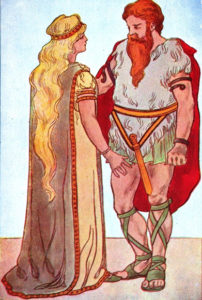
The image above shows Thor and Sif. Image courtesy of germanicmythology.com
In this day and age, wearing a mjolnir pendant symbolizes that you are a racially conscious White person, and when you see another White person wearing one of these pendants you can be at least fairly sure that this person is ideologically aligned with you…at least for the most part.
For some people, wearing a Mjolnir pendant symbolizes believing in the old Norse Pagan religion; however, for me wearing the pendant symbolizes a sense of solidarity with my ancestors and a respect for my northern European genetic heritage along with the culture that sprang from these genetic lines. So, for me, wearing a mjolnir pendant symbolizes a pride in my bloodlines, not what I believe or do not believe. I would also like to say that for me, seeing anyone who is not European or “not White” wearing a mjolnir pendant is disingenuous and even a bit offensive.
Message to Women:
Ideally, an Artaman, National Socialist, or Vokish woman would wear some type of mjolnir pendant when gathering with other people, regardless of the occasion, so a dedicated and aware National Socialist/Volkish woman would ideally have an extensive collection of mjolnir pendants that accompany any mood or occasion.
So, ladies, please feel free to select all sorts of mjolnir pendants that give off all sorts of different vibes. For instance, you can wear a gold piece for formal presentations, and perhaps a copper wire piece for a casual gathering with your female friends. For the young women, wood or stone mjolnir pendants are a great accessory for hiking during the summer months due to their earthy and woodsy sort of feel, and a simple leather piece would be great for working around the homestead. Likewise, a large and ornate carved bone mjolnir pendant might make for a nice accessory at festivals and gatherings. Women are also blessed with the freedom to wear very bright and festive pieces made from colorful resin or paper mache, so ladies, please feel free to take full advantage of the opportunities for self-expression that the mjolnir pendant grants you.
Message to Men:
Ideally, a solid National Socialist, Artaman, or Volkish man would wear a mjolnir pendant whenever gathered with others, yet men should not feel that having a personal selection of mjolnir pendants will make them into something like fussy women. I know, a lot of men have a disdainful attitude about fussing with matters of fashion, and many men tend to see meddling with fashion to any degree as an effeminate matter; but think of it this way, most men have more than one shirt in their closet, so why not have more than one mjolnir pendant?
Luckily, there are many options for very masculine looking mjolnir pendants that would be a great accessory for any occasion, so please feel free to build yourself a collection of different mjolnir pendants that suite differnt occasions. For example, the informal and simple look of a stainless steel pendant, or perhaps a solid surfacing pendant, might be a good fit for doing hard physical work, and a nice bronze pendant might look nice when taking your children out to the local beach. Likewise, a nice polished platinum piece might look good for formal occasions such as weddings and conferences. For the professional man, such as an architect, wearing a nice stone piece at work could create a very sharp look, and for the surfing dude, wearing a plain concrete mjolnir pendant might make for a very sharp accessory. Aluminum pendants might be a nice accessory when running or exercising because they are light weight and offer a cool athletic look. Pendants made from bone or antler might also be a great accessory when hiking or hunting because of their earthy and natural look.
If in doubt, remember the famous quote from ZZ Top: “Every girl’s crazy about a sharp dressed man.”

Image of ZZ Top courtesy of cdn.britannica.com
AVOID ANY PENDANT WITH A MARVEL COMICS THEME OR ORIGIN:
True, a good number of Marvel Comics movies have popularized the old Norse god Thor and placed this character into the mass public consciousness in a way that has not been seen for millennia, which is good. However, Marvel Comic is a totally POZed, Jewish, and Globo-homo operation that stands in total opposition to European people and National Socialism, Artamans, and Volkish people in general, so for this reason it is imperative to only buy mjolnir pendants that have a classic and ancient Germanic pattern. For whatever reason, the Jew named Stan Lee, real name Stanly Martin Leiber, pirated the old Norse gods and tossed them into his fictitious comic book superhero universe, so it is best to totally avoid any mjolnir pendants that draw any inspiration or design elements from old Stan Leiber.
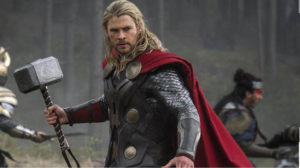
The image above shows the Shabos Goy Hollywood actor Chris Hemsworth playing Stan Leiber’s comic book character in one of the Marvel Comics mass-market films. Image courtesy of ladible.com
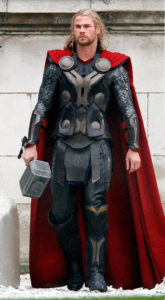
Definitely avoid buying any pendant that resembles Stan Leiber’s bastardized and POZed comic book Thor’s hammer. Image courtesy of cheetsheet.com

The image above is a screen capture from Amazon.com that shows the front page of an autobiographical book about Stan Leiber, who is the creator of the popular Marvel Comics superhero fictitious universe. The book cover seen above is to a book called Excelsior!: The Amazing Life of Stan Lee.

Late-in-life image of Stan Leiber courtesy of theguardian.com
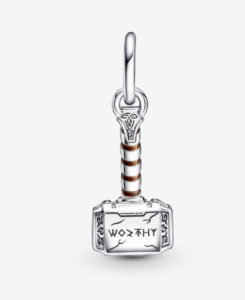
The pendant seen above is a knock-off of the Jewish Marvel Comics Thor’s hammer, so please, do not buy any pendants that look like this. Image courtesy of us.pandora.net
PRESENT PURCHASING OPTIONS:
Metal:
▶︎ Pewter :
Pewter is an ancient metal alloy that dates back to Roman times. The earliest formula for pewter consisted of a mixture with roughly 85% tin and the rest was either lead or copper. Adding lead or copper to the tin mixture resulted in a metal with a relatively low melting temperature that was stiffer and harder than pure tin. Modern pewter alloys that are used for making jewelry are made without lead, but instead they contain about 85% tin, 5-10% antimony, and around 2% copper or silver. Many mjolnir pendants sold on the market today are made from pewter, and this alloy has the advantage of being relatively cheap. In fact, most pewter mjolnir pendants cost less than $20, they are made in China, and they are sold on Amazon. Regardless of their common low cost, there are still some good pewter pendants out there, and etsy.com has them, so do not automatically cross pewter off as an option.
Pros:
- cheap
- low melting temperature means that it can be heated and bent back into shape with a blowtorch fairly easily
- resists oxidation
- not sensitive to prolonged heat, light, or cold
- heating with a common hardware-store blowtorch will remove scratches and dents
- non allergenic
- bends instead of breaking when exposed excessive force
Cons:
- may appear a bit tacky and “cheap”
- soft, so it is easily deformed
- soft, so it scratches easily
- heavy
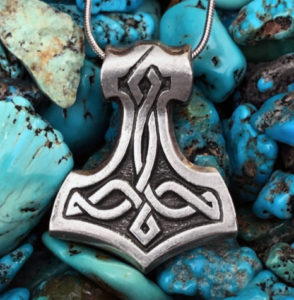
The pewter mjolnir pendant pictured above is courtesy of the CelticKnotWorks shop on etsy.com $22.00
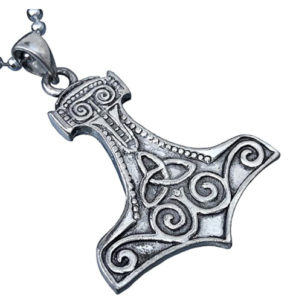
The image above is a pewter pendant sold an Amazon for $9.99
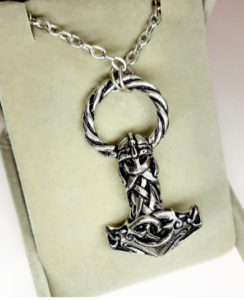
The mjolnir above costs $43.00 and is sold on the EarthStoneLondon shop on etsy.com This mjolnir was included in the mix to show that not every pewter pendant is less than $20.
▶︎ Steel :
For practically all of us, the material called steel needs no introduction, but it is worth noting that many mjolnir pendants are available on the market that are made from plain old steel that has been forged by a hammer using ancient blacksmithing techniques. Mjolnir pendants made from plain old steel are generally not sand cast, so pretty much any steel pendant you can buy will be made in a blacksmith’s forge. The cost of hand-pounded mjolnirs varies from as little as $20 for cheap ones up to $100+ for the really cool Damascus steel models. The problem with steel is that is is prone to oxidizing, so these types of pendants will need to be oiled periodically to avoid rust forming.
Steel is basically made up of Iron with around 0.25% to 0.50% carbon for mild steel and 0.50% to 1.5% Carbon for High Carbon Steel.
Damascus Steel is made by having multiple layers of steel hammered together when hot and then heated and pounded again to fuse all of these layers together more securely. All of the layers of steel that are forged together to form Damascus steel create some interesting patterns.
Pros:
- bends instead of breaking.
- fairly hard and strong
- modestly priced
- forged steel pendants have a strong masculine appearance which makes it a good choice for men
- non allergenic
- not sensitive to prolonged heat, light, or cold
- nice Damascus pendants work well in formal and semi-formal settings
Cons:
- prone to scratching
- prone to oxidation
- may not be a good look for women
- not easily repaired when scratched or deformed
- heavy
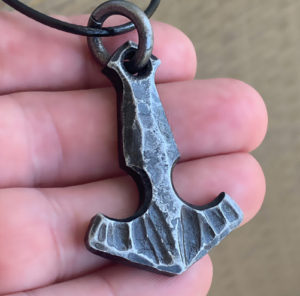
This hand forged pure steel pendant is sold on the Sons of Vikings website and it retails for $49.
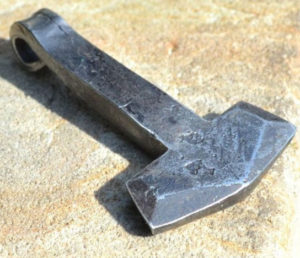
Image of a forged steel mjolnir courtesy of WulfundJewlery shop on etsy.com $22
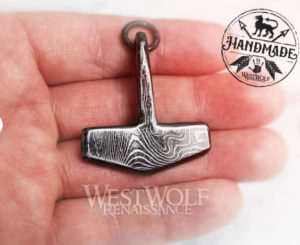
Hand-forged steel pendants are not too hard to find, but they are typically a bit more expensive than some other options. The damascus steel mjolnir seen abobe is presented courtesy of the WestwolfRenaissance shop on etsy.com and retails for $99.
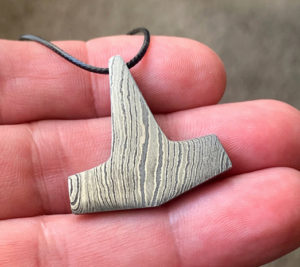
The image above shows a Damascus steel mjolnir pendent that is sold on sonsofvikings.com $39
▶︎ Iron :
For most of us, the metal and periodic table element called iron needs no introduction as a material, so let us just say that this metal is a lot like steel from a functional perspective, except iron is brittle, so unlike steel which bends, iron can chip and break when subjected to stress. The advantages to iron are that is is harder than steel, so it is less prone to scratching and it is less prone to corrosion and oxydation than steel.
Pros:
- resists scratching fairly well
- resists bending fairly well
- not sensative to prolonged heat, light, or cold
- modestly priced
- fairly resistant to oxidation
- great for men becasue it has a strong masculine look and feel
- non allergenic
Cons:
- prone to chipping and cracking under stress
- not easily repaired
- may not be a good look for women
- resits oxydation better than steel, but worse than gold, silver, brass, pewter, bronze, or other non-ferrous metals
- heavy
- not great for formal or semi-formal occasions
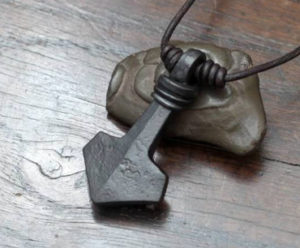
Image of an iron mjolnir pendant courtesy of taitaya shop on Etsy.com $101
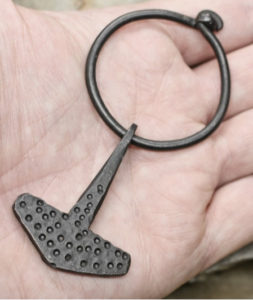
The iron mjolnir pendant featured above is furnished courtesy of the JellingDagon shop on Etsy.com $26
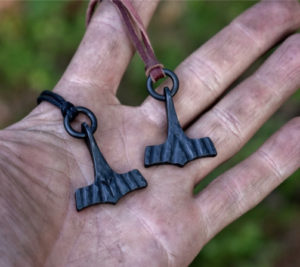
The image above shows a set of small hammered iron mjolnir pendants. Items for sale on KvendlandForgeworks etsy.com shop. $30
▶︎ Stainless Steel:
Stainless steel is just like regular steel; namely, it is made from iron and carbon, but stainless steel has added ingredients such as molybidenum and chromium. Stainless steel offers many of the nicer qualities of steel, such as being strong, but it is less prone to scratching and oxidation than regular steel. Stainless steel mjolnir pendants are not forged by a hammer but pured into sandcasting molds or they are formed when powder is heated in molds and fused to the desired shape. The typical cost of a stainless steel mjolnir pendant is around $25, but some cheap stainless steel mjolnir pendants from China cost as little as $1.50.
The basic alloy mixture of stainless steel is 1.5% Carbon, 10.5% Chromium, and 88% Iron.
Pros:
- cheap
- resists oxydation better than iron or regular steel
- not sensative to prolonged heat, light, or cold
- does not scratch or bend as easily as regular steel
- resists scratching about as well as iron
- works for both men and women
- non allergenic
Cons:
- tends to crack when bent
- not easily repaired if bent or when scratched
- might look a bit tacky or “cheap”
- heavy
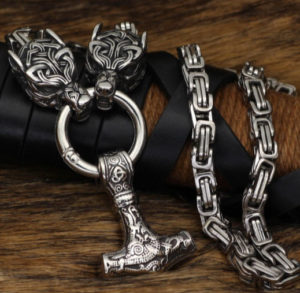
The image above shows an $80 stainless steel mjolnir pendant with an accompanying necklace. This particular mjolnir is shown becasue it is the most expensive stainless steel pendant your humble author has found so far. Image courtesy of VikingWarriorCompany on Etsy.com.
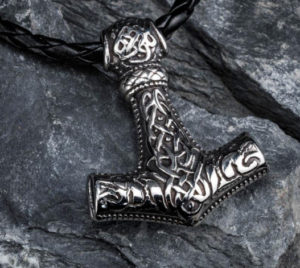
The mjolnir pendant seen above is made of mold-cast stainless steel and is sold on the norsespirit.com website. $25
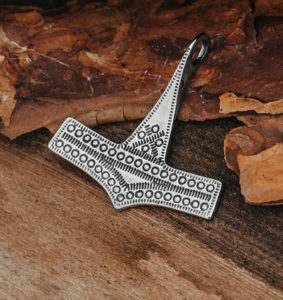
The pendant seen above is a stainless steel Bornholm style mjolnir sold by Grimfrost.com $20
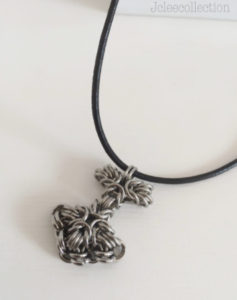
The image above features a mjolnir made of small stainless steel rings. This image comes courtesy of jcleecollection.co.uk 21 GBP
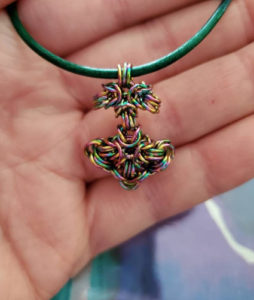
Image of stainless steel mjolnir pendant made from interlocking rings courtesy of AuraLotusCreative on etsy.com $40
The image above shows a 3D-printed mjolnir pendant that is for sale at the “Paraglyphs” store on shapeways.com $71
▶︎ Bronze:
Bronze is an ancient alloy that dates back to at least 4, 000 years ago, hence the term “Bronze Age.” Bronze has traditionally been used to make swords, shields, and armor in ancient times, but in the modern world is is mostly used in marine applications such as for making bushings and propellers for boats. Bronze finds a home in so many boating applications these days becasue this alloy is so resistant to corrosion. Becasue bronze is so resistant to corrosion, this material is also the favorite choice for outdoor statues, monuments, and large bells. Bronze is made up of about 90% copper and 10% tin. Bronze has a nice reddish brown color and mjonir pendants made from this material are typically cast in molds.
Pros:
- fairly hard and strong
- resists scratching fairly well
- resistant to oxidation and corrosion
- not sensative to prolonged heat, light, or cold
- has a nice masculine look that works well for men
- a well-shined bronze mjolnir pendant will work for formal and semi-formal occasions
Cons:
- heavy
- may cause allergic skin reactions
- not easily repaired
- may not be the best fit for women
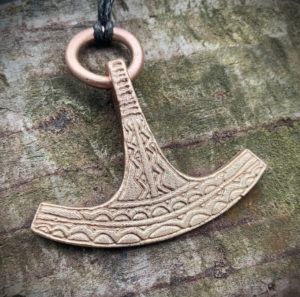
The image above shows a bronze Finnish style mjolnir pendant. This pendant costs $37 and is sold on the OrmeMade shop on etsy.com
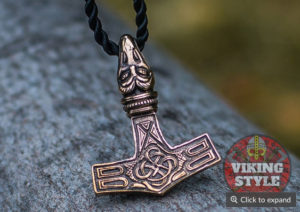
The pendant seen above is sold on the Viking Styles website and retails for around $50.
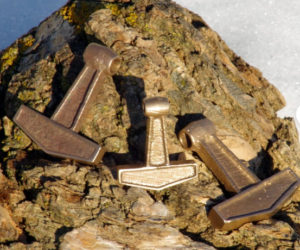
The sandcast mjolnir pendants seen above are for sale at the Mealeurgy shop on etsy.com $30
The pendant seen above is a 3D-printed bronze mjolnir pendant that is for sale on “particleshop” store at shapeways.com $70
▶︎ Brass:
Brass has been in use since around 500 BCE and this material has traditionally been used to make cups, plates, jewlery, and eating utensils. In more modern times, brass is used to make bullet casings, but it is also used to make musical instruments and parts used for marine applications. Brass is a prized material for making bullet casings becasue it is so resistant to corrosion and oxidation, and for this same reason, brass is also often used for outdoor applications such as railings, door knobs, and other things.
Red brass, which is distinguished by its reddish yellow color, is a mixture of about 85% copper and 15% zinc. Yellow brass, which is distinguished by its soft yellow color is about 60% copper and 40% zinc. Mjolnir pendants that are made from yellow brass are cast in molds.
Pros:
- resists corrosion quite well
- resists oxidation fairly well
- not sensative to prolonged heat, light, or cold
- modestly priced
- has a nice look to it
- moderately resistant to scratching
- fairly strong, so it resists bending decently
- works well enough for formal occasions, provided it is well polished
- works well for both men and women
- will bend, but not break under excessive pressure
Cons:
- not easily repaired if scratched
- heavy
- the copper in bronze may cause allergic skin reactions for some people
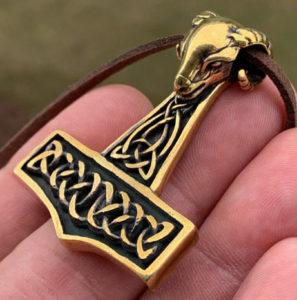
The pendant seen above is made of gold-like yellow brass and is sold on sonsofvikings.com and sells for $30.
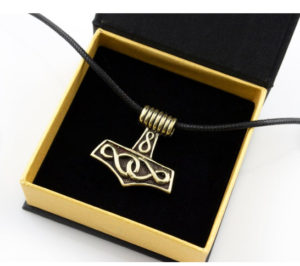
Brass mjolnir pendant courtesy of GameFanCraft store on etsy.com $45
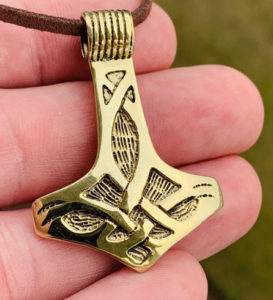
The image seen above is a yellow brass mjolnir pendant that is for sale on sonsofvikings.com for $30
The image above shows a 3D-printed brass mjolnir pendant that is available on the store called “For every passion, a jewel” that is featured on the shapeways.com website. $45
▶︎ Copper:
For pretty much everyone, this metal needs not introduction, but it is still worth discussing the merits and demerits of buying a copper mjolnir pendant. One thing that makes copper an interesting choice of material is the fact that it is very easily bent, so this material lends itself well to hand-crafted wire work.
Pros:
- has a nice look that works well for both men and women
- has the possibility of being worked into wire pieces
- not sensative to prolonged exposure to heat, light, or cold
- can be easily bent back into shape if it is ever deformed
- bends instead of breaking under stress
- relatively low melting temperature lends itself well to repairs of dents and scratches
- dents and scratches can be sanded and polished out fairly easily
- copper has nice anti-inflammatory properties
- it supposedly helps improve the body’s flow of vril, or chi, or mana….or whatever word you want to use to describe life energy and bio-electricity
- copper wire pieces are fairly light for their size, so larger pieces can be worn without too many problems arising from excess pendant weight
Cons:
- the material itself is quite heavy
- relatively expensive
- tends to tarnish and oxidize over time
- bends easily
- easily scratches and dents
- may cause some people to develop skin irritations and bad reactions
- copper may stain the skin green upon prolonged contact, and particularly when moving and sweating a lot
- heavy
- may not work well for formal or semi-formal occasions
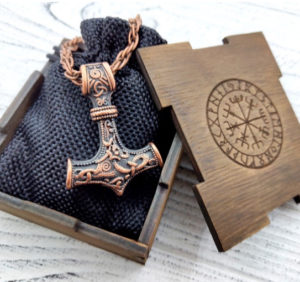
The copper mjolnir pendant seen above is sold on etsy.com’s CrystalStudio store. $50
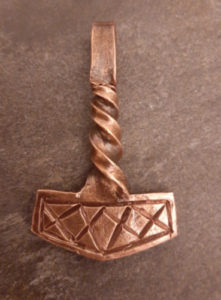
The copper mjolnir pictured above is sold at the CovidaeForge store on etsy.com $56
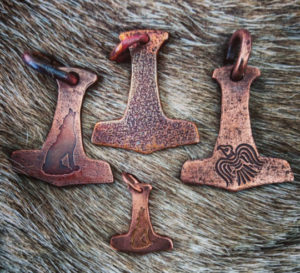
The image above shows a selection of copper mjolnir pendants that are made by cutting shapes from a sheet of copper. Image courtesy of the RuneCastCopper store on etsy.com $54
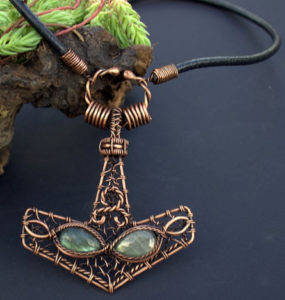
The copper wire pendant seen in the above photo comes courtesy of BoBoWorlds shop on etsy.com $130
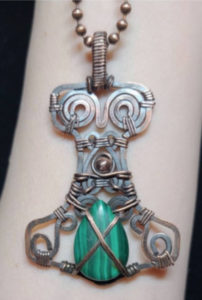
The mjolnir pictured above is made from copper wire and it has a malachite gemstone embedded within the copper work. Image courtesy of LoveYouToDeathGems on etsy.com $60
▶︎ Sterling Silver:
This metal also needs no introduction for most people, but it is still worth mentioning this material as a choice for your next mjolnir pendant. Interestingly, pretty much all of the jewlery and eating utensils sold on the common market today that are considered to be “silver” are actually made of Sterling Silver, which is an alloy of 92.5 % silver and typically 7.5% copper. Pure silver is generally not used to make common items because it is considered to be too soft, so other metals have been added to silver for millennia in order to make items such as coins and jewlery durable to an acceptable degree. Although Sterling silver is fairly resistant to corrosiona and oxidation, it will still tarnish and oxydize over time, just like grandma’s legacy silver eating utensils.
Pros:
- looks shiny and nice
- works well for both men and women
- resists corrosion fairly well
- not sensative to prolonged heat, light, or cold
- some of the more expensive pieces have a decent resale value
- fairly strong, so it resists bending well enough
- tends to bend and not crack
- silver has a nice cache or swagger to it
- some sterling silver pieces are modestly priced
- great for formal and semi-formal occasions
Cons:
- prone to scratching
- not too easy to repair
- relatively expensive
- theft and robbery are a possiblity with more expensive pieces
- does slowly oxydize over time
- heavy
- the copper in sterling silver may cause some people to develop skin allergies or bad skin reactions
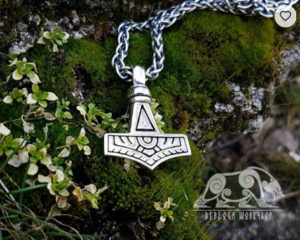
The mjolnir pendent seen above is made of sterling silver and is on offer at the berloga-workshop.com website for $121
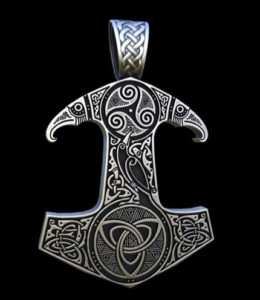
The mjolnir pendant seen above is for sale at the LoniDesignGroup store on Etsy.com $1457
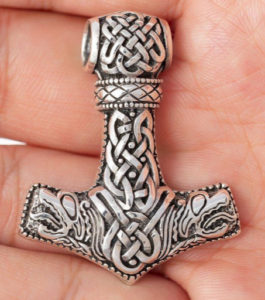
The photo posted above of a sterling silver mjolnir pendant is furnished courtesy of the Norse Spirit website. $66
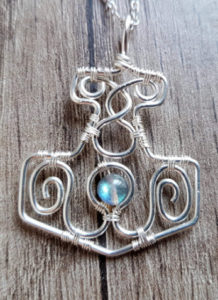
The image above shows a sterling silver wire mjolnir pendant. Like copper, there is a whole range of items made by twisting and bending wire made from this material, and jewlery is one of these items. A limited supply of silver wire mjolnir pendants can be found on the common market, and some places such as Top Knot Concepts can create custom silver wire mjolnirs. The image seen above comes courtesy of ancienttreasures.com $75
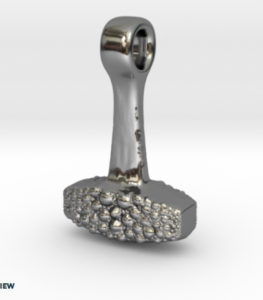
The mjolnir pendant seen above is made from 3D-printed sterling silver and is available on the “Asatru Store” shop from shapeways.com $140
▶︎ Gold:
Gold jewlery is familiar to most people, yet pure gold is rarely used to make jewlery. According to the daimonds.pro website, most common jewelry is made with 14 Karat gold which is 58% gold and the rest is a mixture of zinc, nickel, and copper which is mixed in to add durability. 14 karat gold is the most popular choice for jewelry applications because it has a nice appearance and it resists corrosion, yet it is durable enough to resist scratching, bending, and pitting. 18 karat gold is a similar mixture to 14 karat gold, except the gold content is 75% for this mixture.
14K Yellow Gold: 58.5% gold, 25% silver , 17% copper
14K White Gold: 58.5% gold, 20% copper, 14.5% nickel, 7.5% zinc
14K Red Gold: 58% gold 42% copper
18K Yellow Gold: 75% gold, 12.5% silver, 12.5% copper
18K White Gold: 75% gold, 15% nickel, 5% copper, 5% zinc
18K Red Gold: 75% gold, 25% copper
Pros:
- what can you say, gold is gold…gold has an unparalleled swagger and shine, plus it brings the “bling” factor
- 14 karat gold is fairly durable, so it resists bending and scratching well enough
- 14 and 18 karat gold resist oxidation fairly well
- mjolnirs that are made of solid gold alloys will have a good re-sale values and willing buyers
- will bend and not crack under pressure
- not sensative to prolonged heat, light, or cold
- great for formal and semi-formal occasions
Cons:
- many gold mjolnirs are quite expensive
- gold alloys are not the hardest and most scratch resistant of your choices of material, so scratching and denting are a bit of an issue over time
- gold alloys will need a periodic polishing and refreshing every few years at a jewlery shop because the metals that are mixed with the gold do oxydize over time
- robbery and theft can be an issue
- heavy
- gold alloys used for makng jewlery often cause skin allergies and bad reactions on account of the metals other than gold contained in the mixture
Yellow Gold:
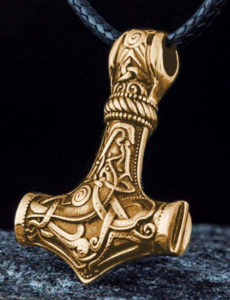
This photo shows a yellow-gold mjolnir pendant that is available on the website called lamuzi.com. These pendants is are available in 10K, 14K, and 18K gold. The cost of a 14K gold version of this pendant on the site listed above is $2000.
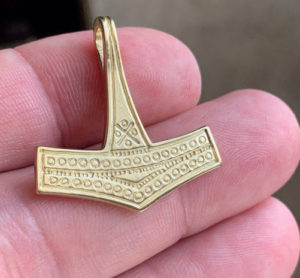
This Finnish style mjolnir pendant is made of 14K yellow gold and sells for $850 on sonsofvikings.com
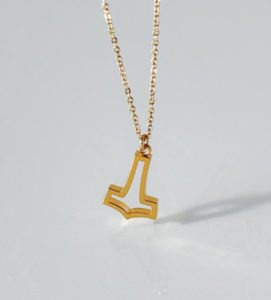
The image above shows a gold womens mjolnir pendant. Image courtesy of goriebreonne.com $98
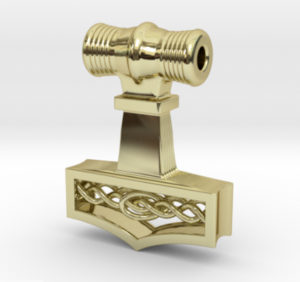
The image above shows a solid 14K gold 3D-printed mjolnir pendant that is on offer at the ” Kleifar Design” shop on shapeways.com $3832
Rose Gold:
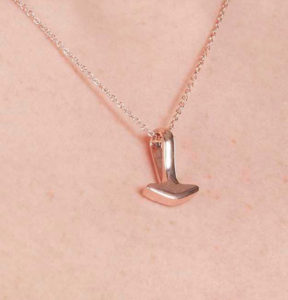
The image above shows a small rose gold pendant designed with women in mind. This pendant sells for 800 Swedish Croners and is on sale at soldier.com
White Gold:
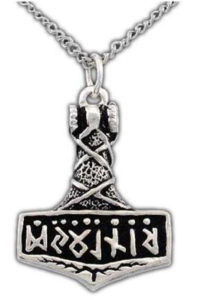
The image above shows a white gold mjolnir pendant that sells for $1205 on badalijewlery.com
▶︎ Platinum:
Platinum? Well, this metal is very expensive, and there are obviously limited options for finding a mjolnir pendant that is made from platinum; none the less, there are still a few platinum mjolnir pendants available on the common market. So, if we are going to have a thourough discussion about your choices for buying a mjolnir pendant, then we might as well discuss platinum.
950 jewlery-grade platinum consists of 95% platinum and 5% palladium, 999 platinum is 99% pure platinum and .990 is 90% platinum, and some platinum mixtures include kobalt as well. So, jewlery plantinum alloys can contain a mixture of platinum and palladium, iridium, rhodium, cobalt, or copper.
Your best option for gettin a platinum mjolnir pendant is to visit the Shapeways website and take a look at some of the shops that 3D-print mjolnir pendants, most of them offer solid platinum as a printing option.
Pros:
- high-purity platinum alloys are very resistant to scratching and chipping
- high-purity plantinum alloys are truly resistant to oxydation and corrosion
- not sensative to prolonged heat, light, or cold
- platinum has a nice lustre and appearance
- platinum bends instead of cracking under stress
- non allergenic
- great for formal and semi-formal occasions
Cons:
- very heavy
- very expensive
The only place so far that offers platinum mjolnirs that are not custom-made are sold by the Loni Design Group on Etsy.com $18,000
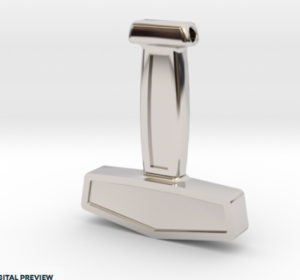
The pendant seen above is made from 3D-printed platinum and is available at the “Dan’s Wonder Emporium” shop on shapeways.com $1620
The pendant seen above is made from 3D-printed platinum and is sold on the “Asatru Shop” on shapeways.com $334
▶︎ Aluminum:
Admittedly, there are not a whole lot of options when it comes to buying an aluminum mjolnir pendant, but mjolnirs made out of aluminun are still available for purchase on the common market. For pretty much everyone, aluminum is a very familair material, so there is not a whole lot of need to explain or to expound on its properties. Today, the most common use for aluminum is disposable beverage containers, but aluminun is now used to make cooking ware and increasingly aluminum is used as the material of choice for bicycle frames. Aluminum has not been in common use for very long, aluminum was officially discovered in 1825, and the first small-scale industrial production of aluminum began in 1856, so aluminum is not one of humanity’s “ancient” metals such as copper, steel, bronze, or brass.
Pros:
- light weight
- inexpensive
- resists corrosion and oxydation fairly well
- non allergenic
- can be bent back into shape fairly easily if deformed
- not too hard to sand and polish-away scratches
- will not rot
- not sensative to prolonged exposure to heat, cold, or UV light
Cons:
- scrathes easily
- bends easily
- dents easily
- does oxdize slowly over time
- limited selection of products available
- not great for formal and semi-formal settings
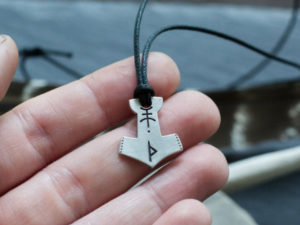
The image above shows an aluminum mjolnir pendant that was simply cut from a sheet. Image courtsy of the WickedGriffin on Etsy.com $21
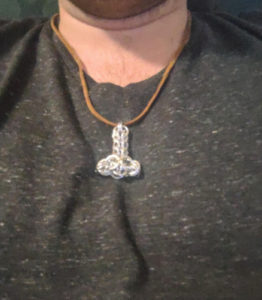
The pendant seen above is made from interlocking aluminum rings and sell for $25 at TheMetalWarren shop on etsy.com
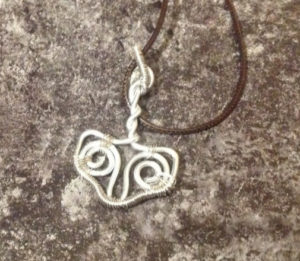
The image above shows an aluminum wire mjolnir pendant that is for sale on the TimeWarpTreasures shop at etsy.com $12
▶︎ Titanium:
Titanium is still somewhat of a rare material, yet many people are still famiar with this metal to some degree. For those who are less familiar with this material, it is a perpiodic table element and a lightweight metal that natually has a deep gray color. Titanium is now finding some common use in jewelry, eye glasses frames, and some high-end sports equipment as well, such as pricey golf clubs. Titanium was only discovered in 1791, but it was not produced for sale to the public until 1910, so like Aluminum, Titanium is not one of humanity’s ancient metals.
Pros:
- light weight
- resists scratching and chipping quite well
- truly resistant to corrosion and oxidation
- will not rot
- not sensative to prolonged heat, cold, or UV exposure
- strong, so it resists bending quite well
- modestly priced
- extremely non-allergenic
Cons:
- tends to crack instead of bend under pressure
- limited choices in mjolnirs, not many people make titanium mjolnir pendants
- may not look quite fitting for formal and semi-formal occasions
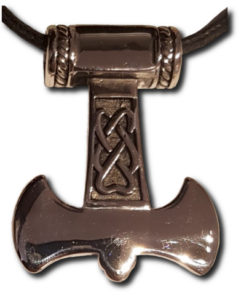
Image of the titanium mjolnir pendant seen above furnished courtesy of thecirclememphis.com $18
▶︎ Mixed Metal:
There are not a whole lot of mjolnir pendents sold that are made up of different metals or metal alloys, but they do exist. The most common type of mixed metal mjolnir pendants are stainless steel models that have been electroplated with differnt types of metal. Electroplating is a process where molecules of a metal are dissolved in a water solution and the piece of metal that is getting electroplated is submerged in that bath of water which contains a mixture of the dissolved plating metal, then an electrical current is run through the piece of metal that is getting plated. When the piece of submerged metal has an electrical current running through, then the metal atoms dissolved in the water solution are attracted to this electrically charged piece of metal, then the dissolved metal atoms and molecules begin to form a thin metal coating on the electrified and submerged piece. Electroplating is often done when a thin coating of gold or silver is desiered to cover on a piece of less precious metal.
The other type of multi-metal mjolnir pendant is one where two differnt types of metal alloy are incorporated into the same jewelry piece. When two tyes of metal are placed within the same jewelry piece, the designer must be sure that the metals are compatible with one another and will not produce galvanic microcurrents of electricity that will greatly speed up the erosion of both types of metal. Because mixing different metal alloys together can create cross currents of electricity that greatly speed up corrosion, mixed metal pieces are rare, and when they are made, both metals tend to be copper-based alloys, such as bass or bronze that is mixed in with copper.
Electroplated pieces are actually nice because their gold platings give them decent appearances, but without the cost of buying mjolnirs that is made of solid gold alloy.
Pros:
- elctroplated stainless steel pieces have the appearance of gold or silver, but for a fraction of the cost
- resists oxydation and rust
- not sensative to prolonged exposure to heat, cold, and UV light
- multi-metal riveted pieces have a very cool appearance
Cons:
- the electoplated covering on a stainless steel piece is prone to scratching
- multi-metal pieces are also prone to scratching
- scratches on the electroplated layer are really not easy to repair
- heavy
- riveted multi-metal peices are prone to getting loosened rivets over time
- copper alloy multi-metal riveted pieces are prone to collecting gunk in their seams over time
The mjolnir pendant seen above is made of stainless steel, but it has sections with gold electro-plating and platinum electroplating as well. Image courtesy of the Prettyrosary shop on amazon.com $23
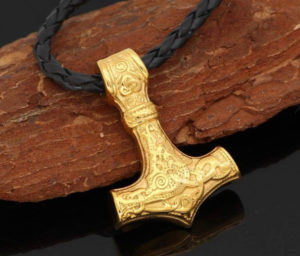
The photo above shows a stainless steel mjolnir pendant that has been given a gold electroplating bath. Image courtesy of ancientreasures.com $18
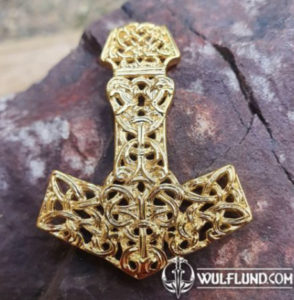
The photo above shows a bronze mjolnir pendant that has been given a thin coating of gold from an electroplating bath. Image courtesy of wulfund.com $24
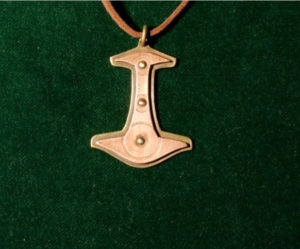
The mjolnir seen above is made from sheets of copper and bronze that are riveted together. Pendants like the one pictuted above that incorporate more than one copper-based metal alloy are somewhat rare, but they are nice looking. Image courtesy of SolarisArt on etsy.com $31
Wood:
Wood is good! Well, that depends on your point of view. For most people, wood needs no introduction as a material, except it is hard to make any sweeping pronouncements about the quealites of wood. It is hard to make any sweeping generalizations about the properties of wood becasue wood comes from trees and there are thousands of differnt species of trees growing around the world that produce all sorts of different types of wood with countless different qualities. For example, Red Cedar is a type of wood that is very light and soft; whereas, some types of wood, such as African Black Wood, are in fact so hard and dense that they are considered to have qualities which mimick those of metals. Other types of wood, such as Argentina’s Quebracha wood, whose name translates from Spanish to English as “Axe-Breaker,” are also very hard and dense, so any items made from this stuff will not break or scratch easily.
Pros:
- prices very considerably, but most wooden mjolnir pendants are not overly expensive
- light weight, so larger wooden pendants will not have an unpleasant amount of weight to them
- non allergenic
- works for both men and women
- many options for colors and many design options – there is a wooden mjolnir for everyone
- does not rust
- dents and scratches can easily be sanded out
- wood has natural antiseptic qualities
- can be glued together easily if broken
Cons:
- will simply break under pressure
- many types of wood are quite prone to scratching and denting
- may tranish over time with exposure to UV light, so your pendent may require an occaional oiling
- prone to drying out and cracking over time if not oiled periodically
- may rot or develop mold if exposed to moisture for long periods of time
- may warp if exposed to moisture for long peroids of time
- prone to staining
- will crack if exposed to continual high levels of heat or cold
- not the best for formal and semi-formal occasions
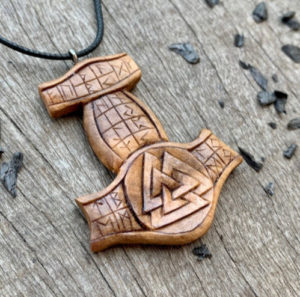
The mjolnir pictured above is a model made from an unknown type of wood. This item was made by Woodzard on etsy.com $42
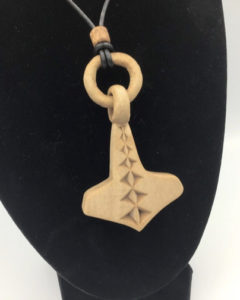
The mjolnir seen above is made from sycamore wood and sells for $75 on the WalkingWoodWorker store on etsy.com
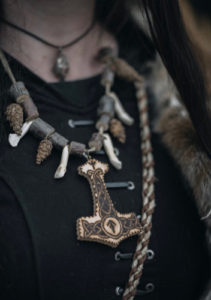
The image of above shows a wooden mjolnir on offer at the CultAccessories shop on etsy.com $80
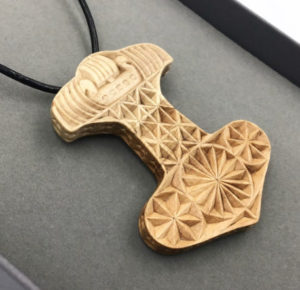
Image above of a mjolnir made from an unknown type of wood is furnished courtesy of the WalkingWoodcrafters shop on etsy.com $62
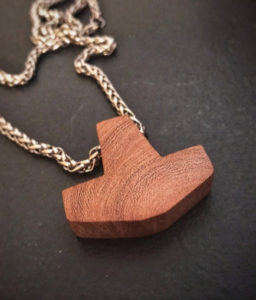
The mjolnir pictured above is made from mesquite wood and sells for $50 on the AmericanHeathen shop at Etsy.com
Ceramic:
Fired clay is a truly ancient material that is still in use today across countless applications, and making mjolnirs is certainly one of these applications. Stoneware is clay that has small peices of fired ceramic ground into it, hence the name “stoneware.” Stoneware clay has a rough texture after it has been fired in a kiln; by contrast, porecelain clay is a very fine type of clay that has a very smooth appearance and texture once it has been fired.
For those who are not familair with pottery, glazes are the glassy coverings that give many finished ceramic pieces their characteristic smooth and shiny finish. Glazes were first discovered when the silicone in wood ash fused to very hot clay pieces during their firing processes and created a smooth and beautiful glass-like finish in the process. The earliest glazes were made from different types of ash, but prior to the discovery of glazes, very fine layers of clay were applied to pottery pieces to give them a smooth finish, these coatings of fine clay were called sigilatas by the ancient Greeks and Romans.
Pros:
- modestly priced
- does not rust, corrode, rot, or oxidize
- unglazed pieces are not UV light sensative
- unglazed piees are not sensative to prolonged exposure to high levels of heat and cold
- many colors are available
- non allergenic
- can be glued together easily if broken
- can also be reapaired with traditional Japanese Kentsugi reapair method if damaged
- glazed ceramic peices have a great feminine charm to them, so these types of mjolnir pendants make great accessories for women
- unglazed ceramic pendants work well for both men and women
- Clay pieces will practically last forever, so long as they are not shattered. Pottery that is thousands of years old is constantly being found at archeological digs around the world.
- glazed ceramic pieces work well at formal and semi-formal occasions
Cons:
- fragile – if you drop a cermic mjolnir pendant, then there is a good chance that it will break
- scratches and chips easily
- breaks under pressure, does not bend at all
- scuffs and scratches in glazed ceramic mjolnirs are not easy to repair
- You have limited choices in products, not many people are offering ceramic mjolnir pendants at this time.
- Many men do not feel confortable wearing glazed ceramic mjolnir pendants because they appear very feminine
- True, ceramic is lighter than the heavy metals such as brass; however, larger ceramic mjolnir pendants will still have an unpleasant amount of weight to them.
- glaze can slowly crack with long sun exposure
- glaze is sensative to cracking under prolonged exposure to high levels of heat and cold
- unglazed peices do not work well for formal and semi-formal occasions
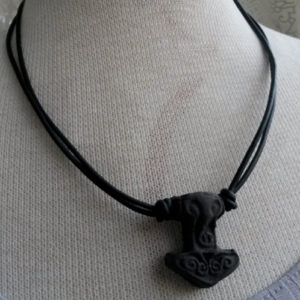
The mjolnir pendant above is made from Raku-fired stoneware clay. For those of you who are unfamilair with the Ruku process, this way of firing clay items involves removing the glowing red-hot ceramic piece from the kiln during a firing process and then placing the very hot item in newspaper of sawdust. During the Ruku firing process, the clay acquires a rustic, rough, and burnt appearance after being put into the sawdust or paper, and Raku peices are not given a coating of galze after the firing process is complete. Image courtesy of ink-design.com Price: 300 Swedish Knoner
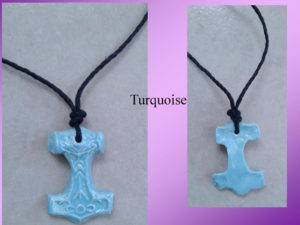
The mjolnir pendent seen above is made from glazed and kiln-fired porcelain and is available on giassecredcreations.com and sells for $28
Animal Products:
▶︎ Bone:
For most people, this material needs no introduction. We all know that bones are the scaffolding that keeps almost every animal moving and standing, so it comes a no surprise that bone was one of the very first materials used to make jewlery. Different types of animal bones are used for making jewelry, but it seems that deer and bovine bones are the most popular choices for making jewelry. True, bird bones can be used to make jewlery, but heavy and strong bones from heavy and large land mamals such as buffalo work the best for making jewlery.
When compared to antler and horn material, bone is notable for being less flexible, but harder. When compared to antler or horn material, bone could be thought of as being a bit more like glass or ceramic than a metal like aluminum because bone is hard and it polishes well, but it is not very flexible.
Pros:
- modestly priced
- non alergenic
- works well for men and women
- light weight
- has a nice appearance
- scratches can be sanded out without too much trouble
- can be glued toghether easily if broken
Cons:
- prone to chipping and scratching
- will crack under pressure
- sensative to UV light, so this material bleaches and cracks in the sun; therefore, mjolnirs made of bone must be kept away from the sun when not worn
- prone to cracking when exposed to extreme heat or cold for long peroids of time
- prone to warping or cracking if kept wet for a long time
- will rot or mildew if exposed to moisture for long periods of time
- prone to staining
- limited choices and offerings
- not the best for formal and semi-formal occasions
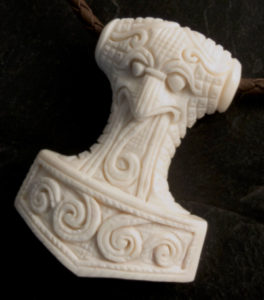
The mjolnir pendent seen above is made from buffalo bone and sold on fly-style-jewlery.com EUR 17.95
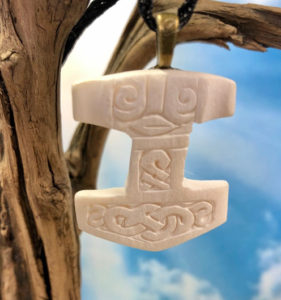
The bone mjolnir seen above is sold on the ThorsHammerGifts shop found on etsy.com $28
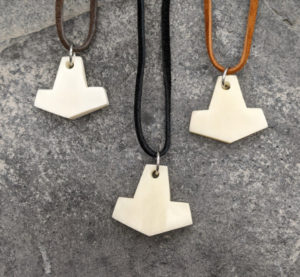
Small mjolnir pendents available on hornsofodin.com $34
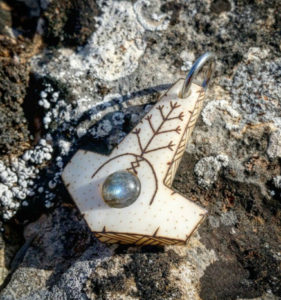
The mjolnir seen above is made from bison horn with a Labrodite jem inserted. This pendant is available on the ThorsThreads shop on etsy.com $124
▶︎ Antler:
The material that constitutes antlers is in fact a bit different than the stuff that makes up bones. Antler material is a lot like bone; however, with antlers the final product contains much more cartilage and fibrous tissue than regular bones, so antler material is much more flexible and springy than regular bone, but not as hard. Antlers are found on male members of the deer family such as deer, moose, and elk, but caribou are an exception in this regard because both male and female caribou grow antlers.
While antlers in are in their growth stage, they are covered by a layer of tissue that supplies the nutrients needed to build the antlers, and this tissue is commonly called “velvet.” Once the antlers are fully developed, the vascualrized tissue that secretes the antler material then falls off and blood flow the the antlers themselves is stopped, and then a fully formed set of antlers sits ready for duels in the rutting season. Because atlers are desiged to be shed yearly, the fully developed antler wracks are really dead tissue that does not have any nerves or blood flow coming to them.
Note: From a materials-analysis standpoing, antler material has pretty much all of the same basic strenghts and weaknesses as bone; however, there are a few differences.
Pros:
- modestly priced
- non alergenic
- works well for men and women
- light weight
- has a nice appearance
- scratches can be sanded out without too much trouble
- can be glued toghether easily if broken
- a bit more flexible than bone
Cons:
- prone to chipping and scratching
- will crack not bend under pressure
- sensative to UV light, so this material bleaches and cracks in the sun; therefore, mjolnirs made of bone must be kept away from the sun when not worn
- prone to cracking when exposed to extreme heat or cold for long peroids of time
- prone to warping or cracking if kept wet for a long time
- will rot or mildew if exposed to moisture for long periods of time
- prone to staining
- limited choices and offerings
- not the best fit for formal and semi-formal occasions
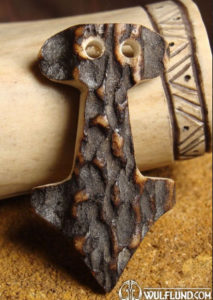
The image above shows a deer antler mjolnir pendent that is available on wulfund.com $14.
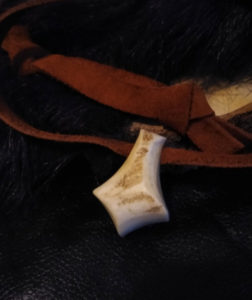
Image of small deer antler mjolnir pendant courtesy of RayStreppCraftShop on etsy.com $59
The image above shows an elk antler mjolnir that is for sale at the RavensCastleCreations store on etsy.com $100
▶︎ Horn:
The material that we commonly call “horn” is made of chitin, which is the same protien that forms human findernails and hair. Unlike antlers, horns are not shed annually; but instead, horns are a permanent fixture on the animal’s head. Horns are found on members of the bovine family such as buffalo and common cattle, but horns are also found on members of the goat family and members of the sheep family which include wild rams.
Antlers primarily exist for males to compete with one another for mating rites during the rutting season; whereas, horns are intended for self defense against predators. Horns have solid bone cores that are sheathed in a chitin shell that is grown from specialed cells which are similar to the cells that produce hair. So, it is the chitin sheaths that cover the bone cores of horns which constitute the material commonly called “horn”. The chitin sheating that covers the bone cores on horns has been used for making buttons and jewelry for untold millennia, but horn-sourced chitin has also been used to make eating utensils and combs for a long time, but the old-time Scandinavians were famous for drinking meade and ale out of chitinous horn sheaths sourced from bovines.
Note: From a materials-analysis standpoing, horn material has pretty much all of the same basic strenghts and weaknesses as bone; however, there are a few differences.
Pros:
- modestly priced
- because the material is flexible, it is will bend as opposed to cracking when placed under pressure
- becasue the material is flexible it is not prone to chipping
- horn can be heated, bent, and then permanently set to a new shapes if it has become deformed
- non alergenic
- works well for men and women
- light weight
- has a nice appearance
- scratches can be sanded out without too much trouble
- can be glued toghether easily if broken
Cons:
- prone to scratching
- sensative to UV light, so this material bleaches and cracks in the sun; therefore, mjolnirs made of horn must be kept away from the sun when not worn
- prone to cracking when exposed to extreme heat or cold for long peroids of time
- prone to warping or cracking if kept wet for a long time
- will rot or mildew if exposed to moisture for long periods of time
- prone to staining
- limited choices and offerings
- not the best fit for formal and semi-formal occasions
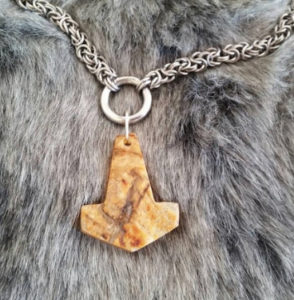
The mjolnir seen above is made from horn sheathing sourced from a ram. This item is made in Spain and is sold on etsy.com’s ThorsThreads shop. $55
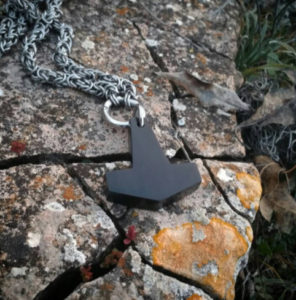
The image above shows a mjolnir pendant that is made from buffalo horn sheathing material. Image courtesy of ThorsThreads store on etsy.com $68
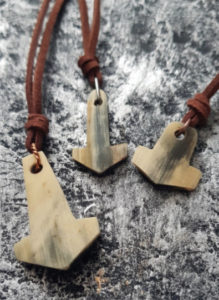
The mjolnir pendants seen above are featured on the LeofricDesigns Etsy store and sell for $24. These pendants are made from the horn sheathing of common livestock cattle.
▶︎ Leather:
Indeed, there are a few mjolnir pendents for sale on the common market that are fashioned from leather. Leather is simply a treated skin from some type of animal. Although the treated skin of bovines is the most common and familiar type of leather for most people, leather made from the skin of pigs and goats is also available, as is leather that is made from the skins of exotic animals such as ostriches, Nile crocodiles, and even anteaters.
Although there is a somewhat modest selection of leather mjolnir pendants available at any given time, any local custom leather works store would probably be more than happy to fashion a custom-made leather mjolnir pendant from a wide selection of leather options.
Leather is one of the most ancient and basic materials that people have been working with for millennia. The actual process of changing raw animal hides into fine leather varies a bit, but the earliest leather making processes involved skinning the animal, removing the hair and gristle from the hide, then allowing the hide to rot for a while in urine or feces in order to soften up, then finishing the process by pounding the hide, smoking it in a smoke house, and lastly finishing the leather sheating with fish oils or rendered animal grease. Later leather tanning methods involved soaking the animal hides in a quicklime solution made by heating limestone in lime kilns then pounding the leather and treating it with dyes and oils, and more modern methods invole soaking raw animal skins in solutions of water and chromium salts.
Pros:
- not very expensive
- light weight
- flexible, so it will not break under pressure
- wide variety of options if a custom piece is made
- non allergenic
- not prone to chipping
- works well for both men and women
- very fine leather can work well for formal and semi-formal occasions
Cons:
- prone to scratching
- will rot if exposed to moisture for prolonged peroids of time
- will dry out then crack and degrade if not oiled somewhat regularly
- will bleach and crack if continually exposed to UV light
- will crack if exposed to prolonged extreme heat or cold
- needs to be oiled every once in a while
- prone to staining
- scratches cannot easily be removed
- limited offerings for pre-made pendants
- The porous nature of leather makes it a natural collectoin point and breeding ground for bacteria, so these types of pendants do need to be kept clean and even sterilized every once in a while.
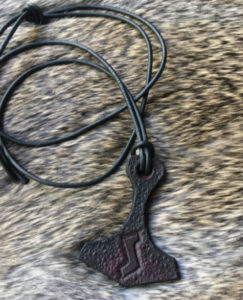
The image above shows a leather mjolnir pendant that is for sale on the KruLeatherWerks shop at etsy.com $25
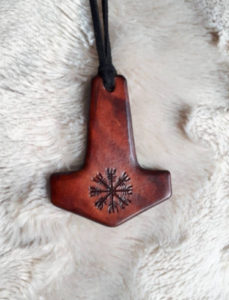
The leather mjolnir pendant seen above is sold on the Elvintree shop on etsy.com $25
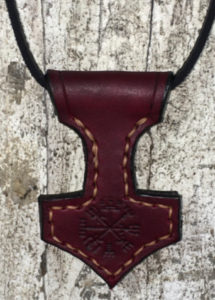
The leather mjolnir seen above is for sale on TheGriffinWorks etsy.com shop. $35

The image above shows a tanned crocodile hide that sells for around $120 could easily be cut and sewn into several mjolnir pendants by a local leather crafter or a local leather shop. Image courtesy of eBay.com
Glass:
Glass is a common material that is all around us in our everyday lives, and this material is commonly used to make windows and disposable drinking vessels for all sorts of beverages such as pre-packaged beer, soft drinks, fruit juices, and iced teas. Glass vessels also frequently hold pre-made food products such as condiments, olives, pasta sauces, and other foods. Besides serving practical functions, glass is also a great medium of artistic expression and has been for thousands of years.
Glass is essentialy a compound of silicone and oxygen, so its chemical formula is SiO2. Glass is made by heating sand in a furnace, and some locations around the world are designated mining areas for high-quality pure sands that are earmarked for glass production. Glass has been made in one form or another for thousands of years, so old glassworking methods are still used to make jewlery.
Glass mjolnir pendants are often made with traditional glass working methods that are thousands of years old, but glass jewelry pieces can also be made by mixing different types of colored glass powders into molds , then fusing the glass powder together in a kiln designed for making jewelry by fusing glass pieces together.
Pros:
- not too pricey
- has a nice appearance
- has many color options
- is completely non-porous so it can be cleaned very easily
- does not rust, decay, or oxydize
- does not rot
- not sensative to prolonged exposure to heat or cold
- not sensative to oxygen or UV light
- very non-allergenic
- can be glued back together easily if broken
- traditional blown glass pieces work well for pretty much any occasion, formal or informal
- can work well for both men and women
Cons:
- will shatter if exposed to stress
- prone to chipping
- prone to scratching
- leaves sharp and dangerous pieces when broken
- not easily repaired if scratched
- larger pieces can be a bit heavy
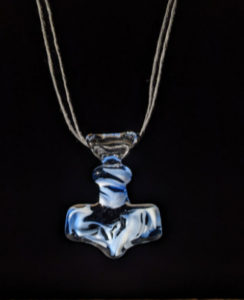
The image of a mjolnir made by traditional glass working techniques is available on the RavenheatRunes shop at etsy.com $45
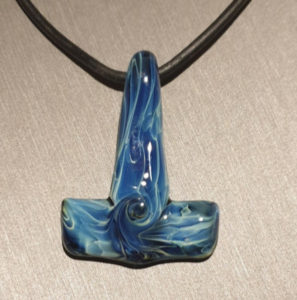
The mjolnir seen above is made by traditional glassblowing methods. Avaialable from the jilleglass shop on etsy.com $45
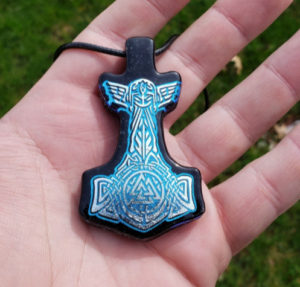
The mjolnir seen above is made by a process of fusing glass powder by placing glass powder in a mold and then fusing the powder in a kiln. Image courtesy of the DarkVitrum shop on etsy.com $45
Stone:
There are all sorts of different types of rocks and gemstones in the world, and it comes as no surprise that people have been making tools and jewlery from different types of rock since the dawn of time, and in our present time making mjolnirs from stone is also a thing.
Many different mjolnir pendants that are made from an assortment of different types of stone are avaialbe for purchase or custom design, so you should look around and see what is available and what suits your tastes before finalizing a purchase.
Pros:
- does not rust or tarnish
- does not rot
- not sensative to temperature or UV light
- non-allergenic
- a wide variety of choices are available
- great for pretty much any setting or occasion, formal or informal
- harder rock is not very prone to scratching
- cracked rock can usually be glued together if it is broken
- price varies, but mjolnirs made from most types of rock are not too expensive
- less heavy than most metal pieces
- typcally not too heavy
- Cons:
- prone to chipping
- will shatter under pressure
- harder rock does not lend itself well to having scratches removed
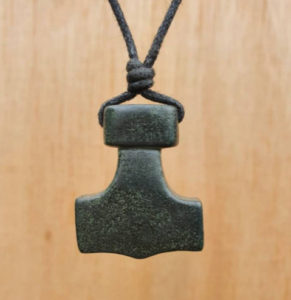
The mjolnir pendant seen above was made by carving a peice of solid stone with an electic or compressed-air motor that spins a diamond-coated cutting bit. The pendant seen above is made of natural Green Granite and sells for $37 on the Carvedinstones etsy.com shop.
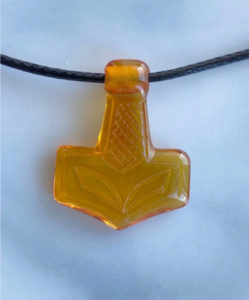
The mjolnir pendant seen above is carved from a solid piece of Baltic Amber from Lithuania. For those of you who are not familiar with Amber, this stone is made of fossilized tree sap that has been burried under the ground for millions of years and has slowly mineralized over time into a unique type of stone. This piece is available on the AmberSmell etsy.com shop for $42.
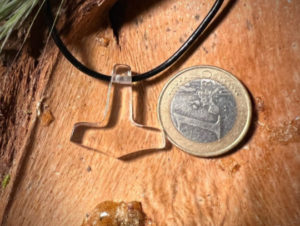
The image above shows a small mjolnir pendant that was carved from a natural piece of clear quartz crystal. Image courtesy of the RavnSoesken etsy.com shop. $20
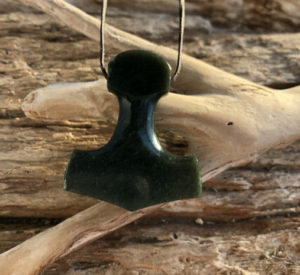
The image above shows a mjolnir pendant that is made from Nephrite Olive Jade mined in Wyolming. The pendant seen above is for sale on the TahanaJade store on etsy.com for $74
Polymer:
The world “Polymer” is just a fancy word for plastic. Most of the plasctics in use today are made by refining and re-working petroleum products and forming them into new custom-made molecules consisting of carbon and hydrogen atoms linked into chains with some other elements such as titanium or antimony thrown in. The best way to understand plastics is to think of them as solid gasoline. Love them or hate them, polymers are around us all the time, and some of these custom-made molecules are used to make jewelry.
▶︎ Poured Resin:
Some resin-based mjolnir pendatns are sold on the common market at this time, but the best way to go is to check and see if the resin that was used to make the pendant was Acrilic-based. Acrilic-based resin is the safest resin to use for jewlery and food-contact applicaions because a pure acrylic-based resin contains no BPA. BPA is the chemical in plastics that mimics the female hormone Estrogen, and it is this Estrogen-minicking chemical that is blamed for so many environmental problems and health problems in today’s world.
Poured resin is a two-part liquid chemical solution that hardens into a clear solid material after the two liquid compoenents have been added and mixted together to form a new solution.
So, is jewleery that is made from acrylic resin safe to wear? The answer on that question seems to be this: Wearing jewlery that is made from a proper Acrilic resin poses no major health problems, especially if the jewlery piece is not worn all of the time. Is that statement supposed to make you feel reassured? Well, consider this, everyone is exposed to BPAs in the environment to some degree at this time anyway, so wearing a resin dendant is just a drop in the bucket when it comes to BPA exposure. Luckily, there is a growing push to get rid of BPAs entirely, and it does look like all BPAs will eventually be phased out of plastic manufacturing — but this change will take time — kind of like it took time to phase out lead from paint and to phase out asbestos use in general.
Pros:
- light weight
- non-allergenic
- easy to repair with a bit of epoxy mixture
- nicks and scratches can easily be sanded out
- does not rot
- has a nice feminine look that is great for women
- works well for women at formal and semi-formal occasions
- many different color options are available
- modestly priced
- surprisingly strong and sturdy
Cons:
- prone to chipping
- has a bit of a femine look that may not be a great choice for many men
- prone to tarnishing, fading, and cracking when exposed to excessive heat or cold
- prone to cracking, warping, slow disintegration, and discoloration if stored in direct sunlight for long peroids of time
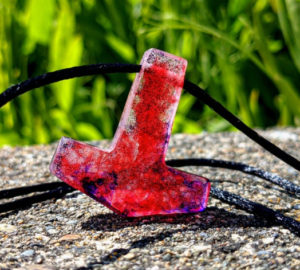
The resin mjolnir pendant seen above is for sale on the WarthogTradeGoods store at etsy.com $20
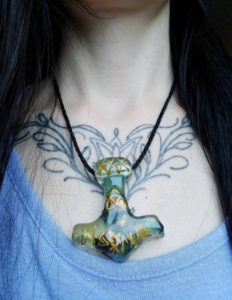
The image above shows a resin mjolnir pendant that is for sale at the MysticPetrichor shop on etsy.com $13
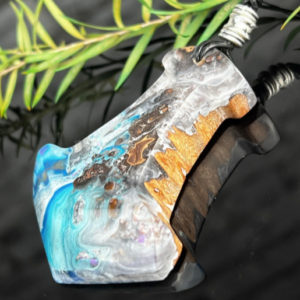
The mjolnir pendant seen above is made from a combination of wood and resin. This pendant is available on the ZietlosSchmuckDesign shop on etsy.com $70
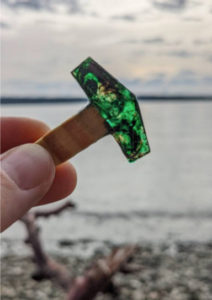
The mjolnir seen in the photo above has a wooden shaft and a resin head. This mjolnir is for sale on the WarthogTradeGoods etsy.com shop. $20
▶︎ Solid Surface:
Acrylic faux stone is now a popular choice of material for kitchen counter tops and sinks of all types, and even floor tiles. Acrylic faux stone is called Solid Surface when it is used for covering couter tops. Acrylic faux stone is a popular choice of material for coutner tops because it is not terribly exepensive, it is totally customizable, it is easy to repair, it is non-toxic, and it is surprisingly durable. Given all of the nice qualites associaed with Solid Surface counter top material, it seems reasonable that someone would think to carve jewlery from this material at some point.
Pros:
- does not rust or tarnish
- easily glued back together if broken
- scratches and scuffs can easily be sanded out
- wide variety of colors and patterns available
- fairly strong
- modestly priced
- non-allergenic
Cons:
- prone to chipping and scratching
- will crack under excessive pressure
- prone to cracking if exposed to extreme heat or cold
- will fade and degrade in the Sun’s UV light over time
- prone to staining
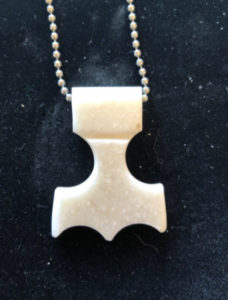
The mjolnir seen above is made from Acrylic faux stone. Image above courtesy of JohnLangevinDesigns on etsy.com $40
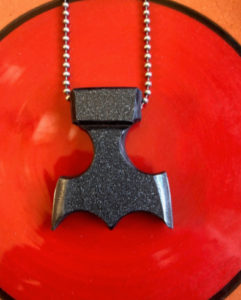
The image above shows another mjolnir pendant made from Solid Surface. This piece is also sold on the JohnLangevinDesigns etsy.com store for $40.
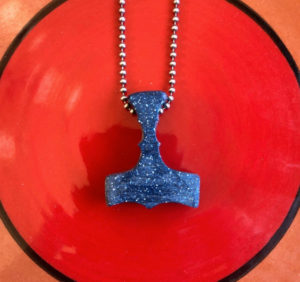
The image above is another Solid Surface mjolnir pendant that is for sale at the JohnLangevinDesgins shop on etsy.com $40
Materials That Are Not Presently Available But Would Be Cool To Have:
Author’s Note:
My hope is that by writing about materials that are not presently being used to make mjolnir pendants I will inspire some of my readers to rectify this problem and start making mjolnirs from materials that are not in use presently. Some of the material choices listed below are not very expensive, nor very complicated to work with, and some of these materials discussed below lend themselves well to home-based craft work that would be a prefect fit for retirees and women who are dedicating their time to caring for their children, but are perhaps seeking a hobby or a home-based business opportunity.
Animal Products:
▶︎ Sea Shell:
She sells sea shells by the sea shore.
The material that forms sea shells is made up of a calcium carbonate mixture that is secred by specializd glands in the bodies of clams, cephelopods, and a host of other sea mollusks. Sea shell material has been used to make eating utensils, jewlery, buttons, and sewing needles for untold millennia, and seas shells are still used to make jewlery to this day. Most of today’s seashell material that is used to make jewlery is sourced from commercially farmed oysters and abalone, but other options are avaialable such as sheeting sourced from conch shells harvested wild in the Bahamas.
Pros:
- does not rust or tarnish
- has a nice appearance
- non-allergenic
- modestly priced
- light weight
- not sensative to UV light
- not prone to craking when exposed to prolonged high levels of heat or cold
- does not rot or mildew
- not prone to staining
- Scuffs and scratches can easily be sanded off
- glues back together without too much trouble if cracked
- great look for women across any type of setting, including formal and semi-formal gatherings
Cons:
- prone to chipping and shattering when exposed to pressure or impact
- prone to scratching
- has a feminie appearance, so it may not be a great look for men
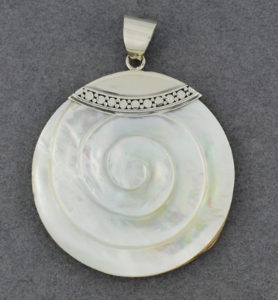
The pendant seen above is made from white oyster shell. Oyster shell does not have the the same amazing colors and patterns that abolone shells do, but the nice shiny white colors of oyster shells would lend themselves well to making nice mjolnir pendants for women. Image courtesy of greenriversilver.com
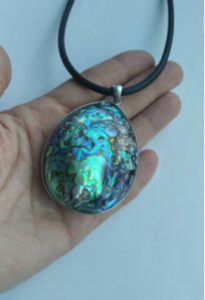
Shells from commercially raised abolone have really nice colors and beautiful reflective qualities, so making mjolnir pendants from this material would be really cool. Image courtesy of the SanaGem shop on etsy.com
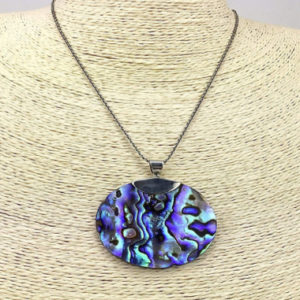
The pendant seen above is a large women’s jewlery piece sourced from the shell of a wild-caught abalone in British Colommbia, Canada. This type of material would make for a nice mjolnir pendant for women. Image courtesy of utopianorthwest.com
▶︎ Ostrich Egg Shell:
Yes indeed, the shells of ostrich eggs are thick enough to make jewlery. I remeber when I was about 5 years old, my father was gifted an ostrich egg by a friend of his who had a few ostriches he was raising out on his rural acreage. I do remember that my mother and father had a tough time cracking the egg, and my father eventually wound up breaking the egg shell with a hammer. I also rember that there was so much egg that came out of that item that my mother was unsure how to cook all of that runny goo, so she wound up making a huge soufflé out of that liquid.
The point to remember here is that the shells of ostrich eggs are actually fairly thick and tough… well as far as egg shells go anyway. There is a long-standing tradition of making jewlery pieces from ostrich eggs shells in the southern parts of Africa, so this materil should be considered for jewlery work. Many of our volkish and Artaman kin are now running farms and homesteads around the world, and it turns out that ostriches actually make nice livestock animals, so more of our people are now raising these giant birds for food, leather, and of course, their giant eggs. If ostrich eggs shells are becomming a more common item, then homesteaders might want to consider making jewlery pieces from this material.
Ostich egg jewlery pieces can be made stronger by stacking layers of eggs shell on top of one another and then fixing these layers together with some type of glue or resin, such as tung oil, gluten paste, animal hoof glue, or hide glue. The layers of egg shell can also be fixed togehter by sticthing them together with wet leather cording that will tighten up when dry.
Pros:
- not terribly expensive
- has a nice look to it
- does not rot or mold
- non allergenic
- not very heavy
- scratches can be easily sanded out
Cons:
- does not bend but cracks under pressure
- prone to scratching
- sanding out scratches that are on the face of the piece can cause the egg shell to loose some of its very cool texture
- degrades a bit in UV light over time, but not like many other bio-materials
- prone to cracking if exposed to extreme heat or cold for long peroids of time
Some people like to paint ostrich egg pendants, like the one seen above. Image courtesy of the EggStArt shop on etsy.com
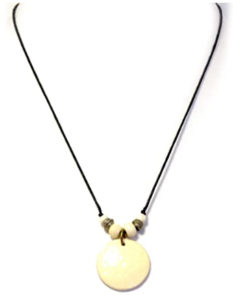
The image above shows a rather plain ostrich egg shell necklace pendant. Image courtesy of Amazon.com
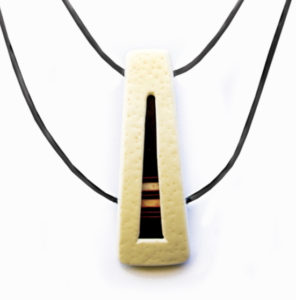
Image of a cool ostrich egg pendant courtesy of thegreatescape.co.za
Felt:
The origin of felt is generally traced back to the Altai mountains of northern Mongolia around the 7th century B.C. Felt was originally made by boiling cut sheep wool and then compressing wet animal hairs to together. The hair strands of sheep, goats, rabbits, beavers, and muskrats will work for making felt, but the hair of other animals in unsuitable for this purpose. The first felting process developed was the “wet felting” process where animal hair is boiled in water and stirred, then the boiled hair is made into a paste-like material and then finally compressed into sheets of varying thickness.
Wet Felting
In the earliest wet felting processes, the boiled and stirred animal hair was put into wooden molds with screening made from vegetable fibers, then compressed and dried. The animal hairs that constitute felt sheeting adhere to one another because each hair in the sheeting is covered in scales of chitin protein that expand when they are heated and saturated with water, but these same chitin scales contract as they cool and dry. When the scales on the animal hairs that form felt are wet and heated, they are expanded, but as these scales cool and dry, they contract and adhere to one another which forms tight matrixes that become felt sheeting.
Although felt is usually thought of as a soft material, sheets of felt made through the wet felting process can also be quite stiff and solid if the wet felting mixture is compacted with a lot of pressure. Many hats made from felted beaver hair are actually quite solid and stiff, so rather sturdy and necklace pendants can be made from felt that has been compacted under great pressure while it is still wet.

The photo above shows the traditional wet felting process being practiced at a contemporary workshop in Nepal. Image courtesy of SmartPaani.com
Needle Felting
Felt can also be formed into sheets and even somewhat complex solid objects by passing felting needles through strands of animal hair and getting them to mat and stick together in the process. Felting needles have small notches on them that are designed to catch the animal hairs and get them to tangle together as the needles are moved back and forth through the strands of animal hair. Most commercially produced felt is now made with machines that rapidly pass notched felting needles through yarns of animal hair. The needle felting technique allows a skilled artist to create three-dimensional forms from matted animal hair which includes flat sheeting and intricate sculptures.
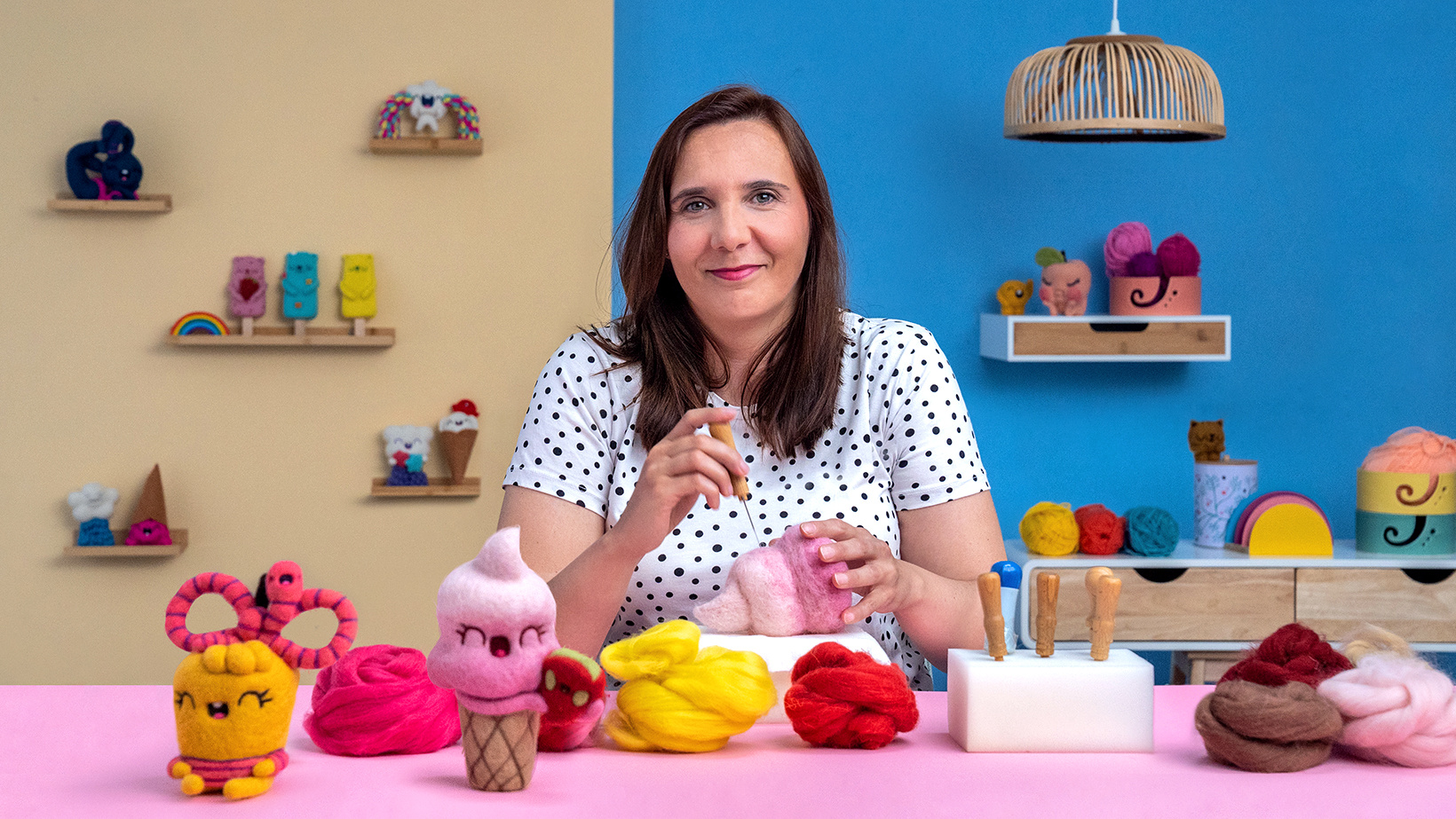
The image above shows the creations of a skilled needle felting sculptress. This image above also shows the artist with her trusty notched felting needle in hand. Image courtesy of domestika.org

The image above shows small sculptures made by the traditional needle felting process. Image courtesy of mymodernmet.com

The image above shows a necklace made by the traditional hand needle felting process. Image courtesy of zazzypeacockstudios.com
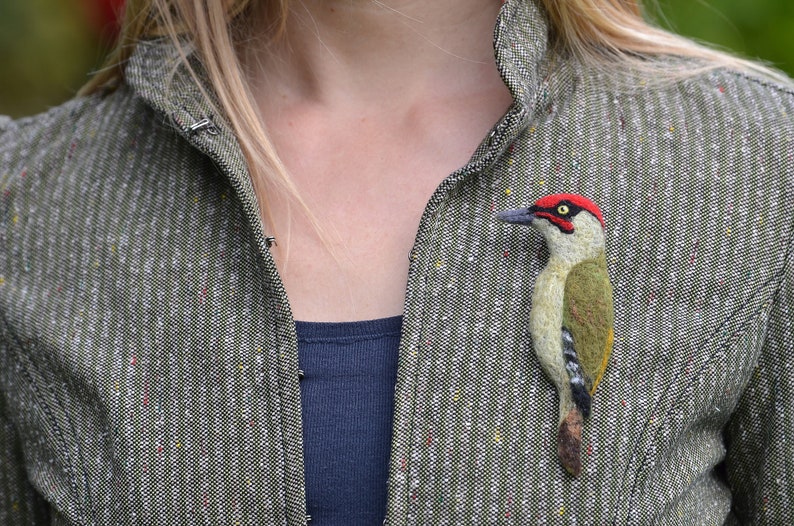
The image above shows a brooch pendant that was made by needle felting. This photo is included here to illustrate that mjolnir pendants can easily be made through the needle felting process, and to show that it would be cool to have someone offer mjolnir pendants made from this technique. Image courtesy of the Peacock Felt shop on Etsy.com
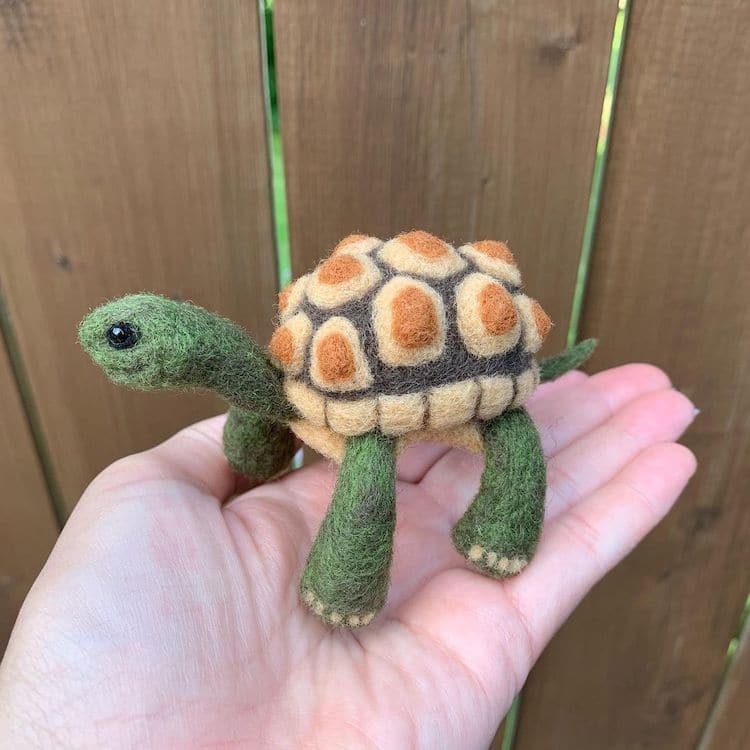
The image above shows an intricate sculpture that was made by needle felting. Image courtesy of mymodernmet.com
Some necklace pendants that are sold to the general public at this time are made from flat sheets of felt that have been sewn together. Image courtesy of momsandcrafters.com

The image above shows a sewn felt necklace pendant. This photo is included to illustrate that the technique of sewing sheets of felt together could easily be used to make some very cool mjolnir pendants. Image courtesy of Audrey on flikr.com
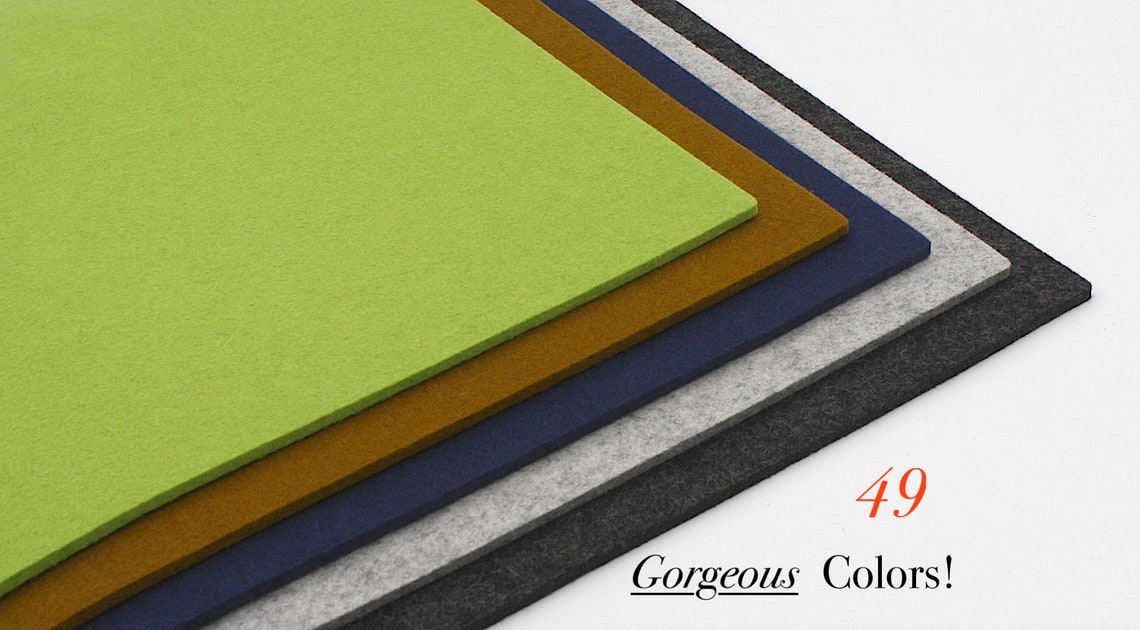
Another option for making felt mjolnir pendants is to simply cut mjolnir shapes from sections of industrial wool felt sheeting that is commonly used for insulation and protecting sensitive pieces of equipment from physical harm. Image courtesy of the Wool Felt Depot on Etsy.com
Pros:
- inexpensive
- many choices of color
- will not break when dropped
- will not scratch or scuff
- not very heavy
- easy to make in the home
- doe not require much time to learn the skills needed to make pendants with these materials
- Having A wide variety of color choices offers design options that would work well for both men and women
- easy to repair if damaged
Cons:
- prone to molding if kept wet
- prone to staining
- will hold a lot of bacteria if not cleaned regularly
- will bleach in and degrade if left exposed to UV light for long periods of time
Concrete:
Yes, concrete does in-fact serve as a great material for making jewelry. Concrete jewlery is made by pouring concrete into a mold, usually a flexible silicone mold, and then allowing the mixture to dry and form a solid shape.
Pros:
- Can be easily made in-home for a very low price.
- Custom-made rubbery silicome molds are avaialable that offer an almost unlimited set of design possibilities.
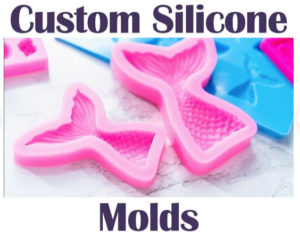
The image above is from the 3DDexuleStore on etsy.com This Etsy shop offers its customers custom-made silicone molds that are good for making jewlery as well as pouring chocolates. - Concrete is easy cheap and easy to find, and there is now a company that makes a type of concrete which is specially formulated for making jewelry and other art projects.
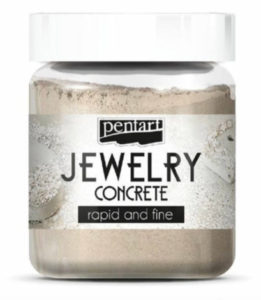
The image above shows specialty jewelry concrete that is for sale on etsy.com and other places. The image above is sourced from the PickersPalaceTexas shop on Etsy and sells for $22. - Concrete is actually quite light; concrete weighs a little less than pure aluminum by volume, so larger pieces of jewlery can be made from this material without having the burden of excess weight.
- pigments can be added to the wet mixture that offer an almost unlimited number of colors
- non allergenic
- Very cheap and easy to reapair if there is any type of problem. Any problem ranging from a chip, to a scratch, to a total shattering of the entire item can be easily fixed by simply putting the pieces back into the mold where it was made and then adding new concrete to the mold.
- pigmened and colored concrete is a great look for women that will work in any setting
- raw concrete, or concrete that is colored in darker shades works well for men
- not sensitive to hear or cold
- not sensitive to UV light
- does not rot, mildew, or decay
- lends itself to being painted
Cons:
- Prone to chipping
- will shatter and crack if exposed to excessive pressure or force
- brightly colored concrete pendants will not be a common choice for many men because they have too much of a feminine appearance
- for men, concrete pendants of any color may not be the best choice for formal or semi-formal occasions
- somewhat prone to staining
- can pick up gunk and bacteria over time if not cleaned regularly
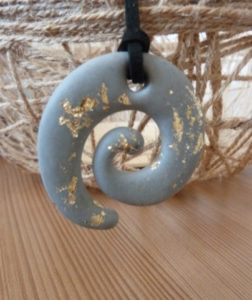
Image of the concrete pendant seen above is furnished courtesy of the ConcreteJewleryArt shop on etsy.com
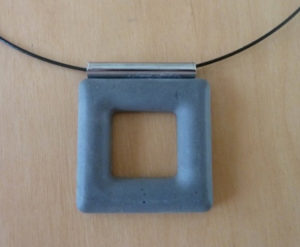
The image above shows another example of concrete jewlery. Image courtesy of ConcreteJewleryArtShop on etsy.com
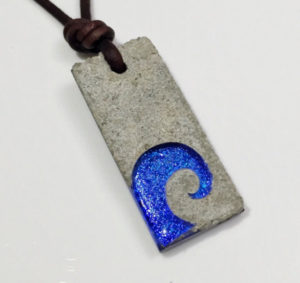
The pendant seen above is a surfer-inspired piece made from polished concrete with a melted glass powder inlay. Divits and grooves in concrete jewelry lend themselves well to having fused glass artwork incorporated into the final piece after the glass powder has been fused and attched to the rest of the concrete piece by heating the piece in a kiln. Image courtesy of bettersurfthansorry.com
Paper:
▶︎ Paper Mache:
Paper mache is basically wet paper that has been fastened together by some type of binding agent. The binding agent used to hold the paper together can be glue made from horse and cow hooves or it can be a wheat-based gluten paste. Not surprisingly, paper mache finds many uses in any place soon after paper making is introduced, so this method of construction is not a new idea.
Objects made from paper mache is formed by making a clay-like pulp of wet paper that is mixed with some type of binding agent. Many paper mache mixtures also incorporate salt which acts as an anti-rot preservative. Paper mache objects that are made with salt added into the main mixture and then coated with some type of resin or laquer after the main building material has dried thoroughly, such as boiled linseed oil or tung oil, actually last a good long time and are surprisingly strong and sturdy.
Some very elegant paper mache jelwery is available on the common market, so it would be cool if someone made a selectoin of mjolnir pendants from this material.
Pros:
- Custom silicone rubber molds are avaialbe that make for easy production with a high level of detail.
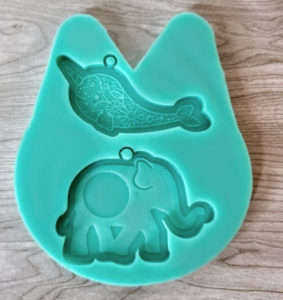
The image above shows another custom-made silicome rubber mold. Image coutesy of the SiliconeMolds77ART shop on etsy.com - a paer mache mixture is surprisinlgy strong when finished
- light weight
- low cost
- easy to make in-home
- easily repaired if broken including breaks, chip, and scratches
- not prone to chipping
- non-allergenic
- lends itself well to being painted
- bright colors are a great fashion option for for women
- darker colors will work well for men
Cons: - somewhat prone to scratching
- will rot and wildew if exposed to excessive moisture for long peroids of time
- will carck or bleach if exposed to the Sun’s UV light for long peroids of time
- bright colored paper mache pendants do not look good on men
- prone to cracking if exposed to extreme heat of cold
- does not lend itself well to hard edges
- prone to staining
- will acquire bacteria and gunk over time if not cleaned periodically
- will crack and not bend under pressure
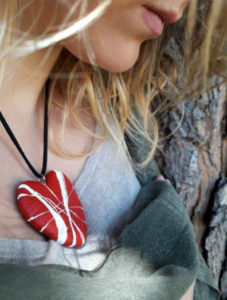
The pendant seen above is made from dried and painted paper pulp that is probably held togehter with some type of gluten paste. Image courtesy of the Sognoametista shop on etsy.com
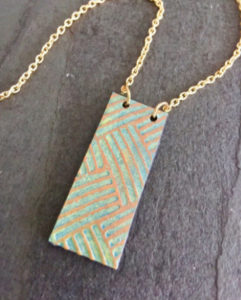
The pendant seen above is actually made of paper mache, so this material can be used to make some pretty nice jelwery pieces. Image courtesy of the AtomicPaper shop on etsy.com
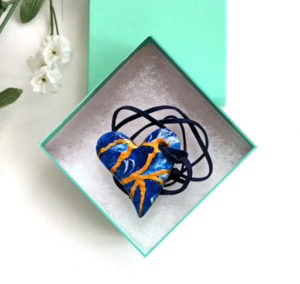
The image above shows a paper mache pendant that is for sale on the UniqueArtGiftsBy3xRe shop on etsy.com
▶︎ Layered Paper:
Layered paper has been used as a building materials ever since paper made its way into common use. Items made from layers of paper stuck together with some type of binding agent have been around in Europe and Asia for millennia, so this material is nothing new. This material seems like it would be a great option for home-based jewlery making becuase the methodolgy for this technique is so simple and the costs associated with this technique are so low, yet the possibilities for artistic expression within this media are so tremendous. Basically this method of building involves sticking layers of paper together with wheat paste, some type of animal-based paste made from cow or pig hooves, or perhaps some type of natural lacquer like tung oil or boiled linseed oil, then compressing the layers and allowing the binding agent to set and dry. The final product should be sealed with a few layers of boiled linseed oil or tung oil and then it will be set for use.
Pros:
- final product is surprisingly strong
- light weight
- inexpensive
- easy to produce in-home
- non-allergenic
- tremendous variety of colors and design options exist
- scratches and scuffs can easily be sanded out and repaired
- different color schemes make this medium workable for both man and women
- Broken pieces can be easily glues back together
- Cons:
- somewhat prone to scratching and chipping
- The sealant coating and the paper itself will bleach and degrade in the Sun’s UV light over time, so these pieces must be stored away from sunlight.
- will mildew and rot if continually exposed to moisture
- prone to cracking if exposed to extreme heat or cold
- prone to staining
- will crack and not bend under pressure
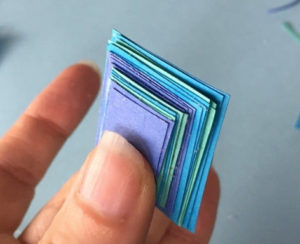
Image above furnished courtesy of kenarry.com
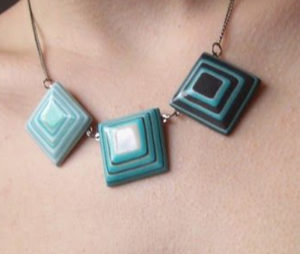
The image above shows finished and polished paper jewelry pendants. Image courtesy of Ann Martin on Pinterest.com
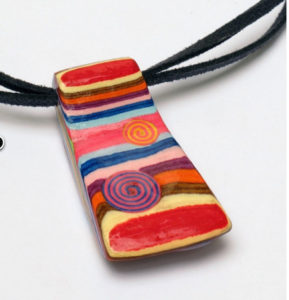
The image above shows a colorful necklace pendant that is made from layered paper. Image courtesy of yiannismargetis.com
Non-Wood Plant Materials:
▶︎ Coconut Shell:
Coconut shell is not wood, so it should be discussed as a different material. Coconut shell is worth mentioning because it is a nice-looking, low-cost, and durable material that would work well for making mjolnir jewlery. Some people might say that this material has too much of a tropical appearance that is not compatible with a Nordic European theme, but I would just say that coconut shell is simply a material for making jewlery, so there is no real problem with using it, and it can also be a nice cool material for making mjolnir pendants for White folks living or traveling in tropical surf locatins such as Northern Australia or the Hawaiian Islands. Coconut mjolnir pendants could also work well for White surfers in places like Florida or Southern California.
Author’s Note:
Coconut shell has pretty much all of the same pros and cons as wood.
Pros:
- prices very considerably, but most coconut shell mjolnir pendants would not be overly expensive
- light weight, so larger wooden pendants will not have an unpleasant amount of weight to them
- non allergenic
- works for both men and women
- does not rust or oxidize
- dents and scratches can easily be sanded out
- can be glued together easily if broken
Cons:
- will simply break under pressure
- prone to scratching
- may tranish over time with exposure to UV light, so your pendent may require an occaional oiling
- prone to drying out and cracking over time if not oiled periodically
- may rot or develop mold if exposed to moisture for long periods of time
- may warp if exposed to moisture for long peroids of time
- prone to staining
- not the best choice for formal and semi-formal occasions
- prone to cracking if exposed to high levels of heat of cold for long peroids of time
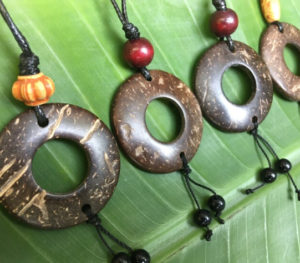
The image above is furnished just to show that coconut shell could easily be worked into nice-looking mjolnir pendants. Image courtesy of the DimiSriLanka shop on etsy.com
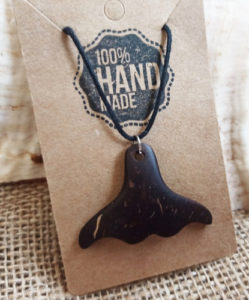
The image above shows a coconut shell pendant shaped like a whale tail, but coconut shell can be carved into a mjolnir shape without too much trouble. Image courtesy of JojitoCreations shop on etsy.com
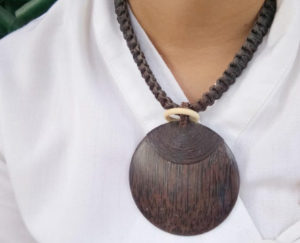
The photograph of a large coconut shell pendant seen above is furnished courtesy of lifesaavy.com
▶︎ Bamboo:
After a bit of searching, it became clear that almost nobody is really making jewlwery from peices of bamboo, but they should be because bamboo has a nice look to it, it is durable, and it is not terribly expensive or hard to shape. Bamboo is certainly not a type of wood because the bamboo plant is actually a large type of grass and the stems of bamboo plants have a lot of embedded silicone in their stems which gives this material very different qualities than wood. Some people might say that bamboo is a lot like coconut shell in the sense that is does not seem very “Nordic” or “Germanic” as a material, but keep in mind, it is just another choice of artistic medium for making a piece of jewlery, so feel free to use it. Bamboo also works well for capturing a summer type of vibe, and this material will look cool as mjolnirs for racially conscious White surfers along with White retired millionaire beach bums and White trust-funders living in Costa Rica.
Author’s Note:
Bamboo has pretty much all of the same pros and cons as wood.
Pros:
- prices very considerably, but most bamboo mjolnir pendants would not be overly expensive
- light weight, so larger bamboo pendants will not have an unpleasant amount of weight to them
- non allergenic
- works for both men and women
- does not rust or oxidize
- dents and scratches can easily be sanded out
- can be glued together easily if broken
Cons:
- will simply break under pressure
- prone to scratching and denting
- may tranish over time with exposure to UV light, so your pendent may require an occaional oiling
- prone to drying out and cracking over time if not oiled periodically
- may rot or develop mold if exposed to moisture for long periods of time
- may warp if exposed to moisture for long peroids of time
- prone to cracking if exposed to pronlonged high levels of heat or cold
- not the best for formal and semi-formal occasions
- prone to staining
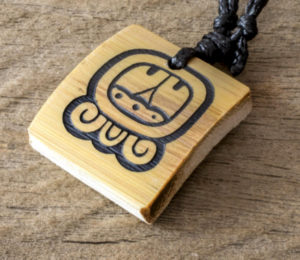
Image of bamboo pendant courtesy of the Pencils of Promise Artisan Shop website.
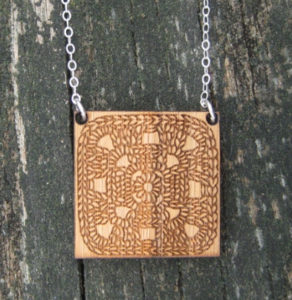
Image of a bamboo pendant seen above is furnished courtesy of katrinkles.com
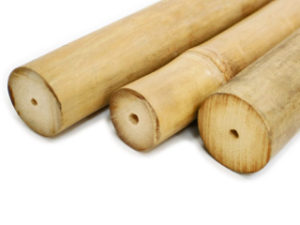
Some types of bamboo will yeild plenty of solid material to make perfectly flat mjolnir pendants with. Image of bysxcommercial.com
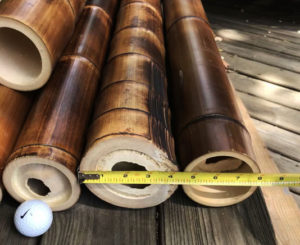
If you are willing to have a pendant with a bit of curvature, then using large bamboo stalks like the ones seen above opens the door for many design possiblities. Image courtesy of bamboousashop.com
▶︎ Tree Bark:
Not many pieces of jewelry are made from tree bark, but the most attractive tree bark material for making jewelry is cork. The material we call “cork” is made from the inner bark of the Cork Oak tree that primarily grows in Spain and Portugal, but these trees also grow in other places. Most of us are familiar with the cork material because it is used as stoppers for bottled wines, bottled beer, and other bottled alcoholic beverages such as tequila. Cork may be most well-known as a material for stopping up the tops of beverage bottles, but cork is now finding many new uses as an insulating material and cork is increasingly finding uses in such applications as a lining material for cloth and cork is even beginning to see more use as a construction material. “Cork Leather” is the term used to describe a class of fabrics that is made by glueing strips of cork tree bark to a substitute of cotton cloth. Fabrics made from cotton cloth that has strips of cork glued on have qualities that mimic those of leather, so cork coated fabrics are becoming a partial replacement for leather.
Pros:
- inexpensive
- light weight
- non-allergenic
- cork has natural anti-bacterial properties
- easily repaired if broken
- scratches and scuffs can be easily sanded out
- works well for both men and women
- has a earthy and natural look
Cons:
- will simply break under pressure
- prone to scratching and denting
- may tranish over time with exposure to UV light, so your pendent may require an occaional oiling
- prone to drying out and cracking over time if not oiled periodically
- may rot or develop mold if exposed to moisture for long periods of time
- will crack if exposed to extreme cold for long periods of time
- will pick up a coating of gunk if not cleaned periodically
- although cork has natural anti-bacterial properties, this material will still collect a lot of bacteria over time if it is not periodically cleaned

The image above shows a harvested section of bark from a Cork Oak tree. Image courtesy of laflorparis.com

The image above shows cork panels that are cut directly from sheetings of cork tree bark. Image courtesy of housewrightgallery.com
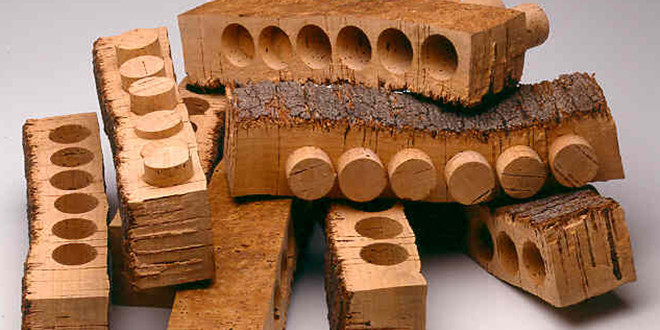
The image above shows the potential of cork bark for making sheeting and then cutting mjolnir pendants form the cork sheeting. Image courtesy of 100%cork.org
Some necklace pendants made from cork are presently offered to the general public, but nobody is currently offering mjolnir pendants made from the inner bark of Cork oak trees. Image courtesy of blessedbysparkeles.com

Image of a cork necklace pendant courtesy of piperlilly.com
Metals :
▶︎ Annodized Machined Pieces of Metal :
Annodizing is a proces where a piece of metal is placed in a bath of water and an electrical current is run through the submerged piece of metal which results in a layer of oxydized metal forming. The final color of annodized metal depends on the electrical current used as well as the combination of catalyzing chemicals put into the water.
Annodization is a remarkable process because it produces such intense and vibrant colors. Mjolnir pendatns can be easily fashioned by cutting shapes from solid plates of titanium or aluminum and then annodizing the cut and prepared pieces. Thick and angular mjolnir pendants can also be made by machining solid blocks of metal to the desired shapes by using CNC machines, then annodizing the finished peices of metal.
Author’s Note:
Annodized metal items are really just the same material as non-annodized metal pieces, except the annodization process just adds really cool colors.
Pros:
- annodized metal has amazing colors
- titanium and aluminum are both light weight
- neither type of metal rusts of corrodes
- Pendants made from annodized aluminum or annodized titanium can have a cool “tactical” or “athletic” appearance that would be great for exercising and a great accessory for sproting events such as running and ball sports.
Cons:
- scratches in annodized metal are not easy to fix
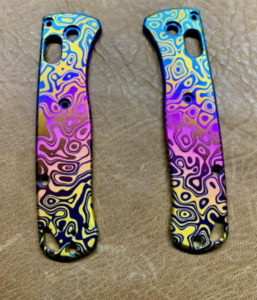
The image above shows the side pieces on a lock-blade pocket knife that are made from Damascus pattern annodized titanium. Image courtesy of worthpoint.com
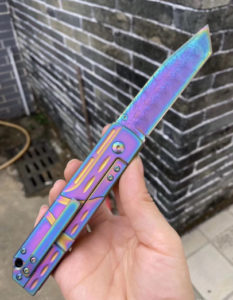
The image above shows an annodized titanium pocketknife. Image courtesy of dhgate.com
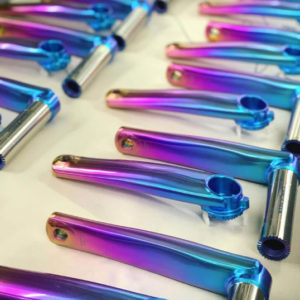
The image above shows another example of the color possibiliteis offered through the process of annodizing titanium. Image courtesy of titaniumfinishing.com
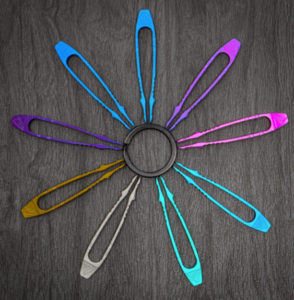
The image above shows examples of annodiazed titanium parts in different vibrant colors. Image courtesy of triiaxis.com
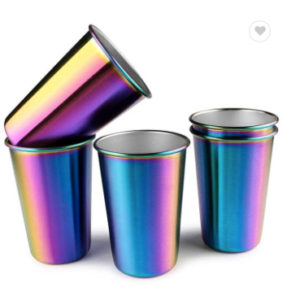
The image above shows annodized aluminum camping cups. Image courtesy of alibaba.com
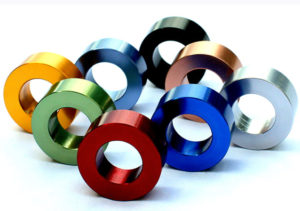
The image above reflects some of the possible solid color choices available from the annodizing process for aluminum. Image courtesy of rapiddirect.com
▶︎ Annodized Aluminum Wire:
Mjolnir pendants made from aluminum wire were mentioned earlier, and a very limited number of mjolnir pendants that are made by twisting aluminum wire are available on the market; however, nobody has invested in making any annodized aluminum wire mjolnir pieces so far.
Pros:
- annodized aluminum wire is cheap and easy to get
- annodized aluminum wire has a huge variety of color options, so this material can work for both men and women
- pendants made from annodized aluminum wire are fairly light
- damage to a pendant can easily be fixed with a little bit of bending
- annodized aluminun is even more resistant to oxydation and tarnishing than regular aluminum
Cons:
- aluminum is prone to scratching
- scratches in annodized aluminum cannot be easily sanded out
- not a good choice for formal occasions
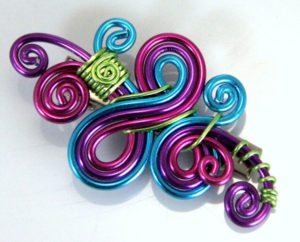
The image above shows a pendant made from brightly colored annodized aluminum wire. Image courtesy of melissawoods Etsy shop.
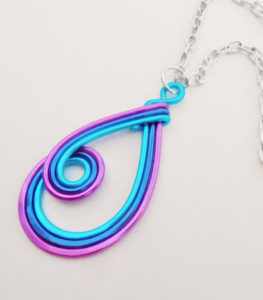
The pendant shown above is included in this series to illustrate the creative potential of annodized aluminum wire. Image courtesy of RefreshingDesigns on etsy.com
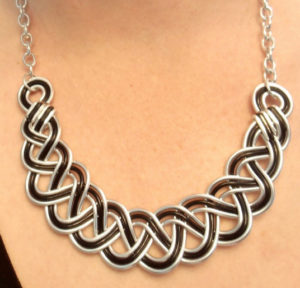
The image above is included to show the potential of annodized aluminum as an artistic medium, but this photo is also meant to illustrate that not all of the color choices for annodized aluminum are extremely bright and loud. Image courtesy of RefreshingDesigns on Etsy.
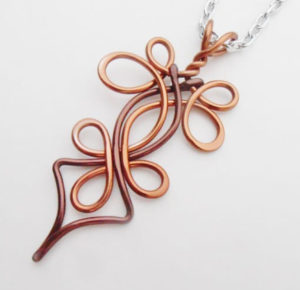
The image above shows an annodized aluminmu wire pendant with a color scheme that would work well for men. Image courtesy of the RefreshingDesigns shop on Etsy.
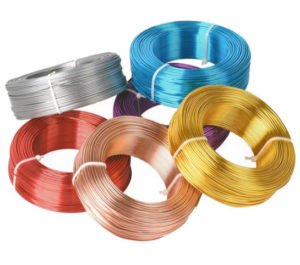
As see above, annodized aluminum jewlery wire is cheap and easy to get and comes in a huge array of colors. Image courtesy of the cinderellaroom store on etsy.com
Cobalt Chromium:
Cobalt Chromium is a relatively new alloy mixture that is commonly used to fashion joints and flanges for gas and oil pipelines, but it is also used to make bio-implants such as hip joints and pins that hold badly broken bones together. There is currnelty a lot of reserch going on to detemine if Nickel Kobalt implants pose any real danger to the people who have these pieces of metal in their bodies, but so far no solid evidence of physical harm has materialized.
The government of Denmark commissioned a study to explore any possible bad effects that might result from men wearing cobalt chromium wedding rings, and the study found that if the metal alloy was of good quality and sourced from a reputable and certified producer, then no elevated levele so cobalt were seen in the blood of men wearing these types of wedding rings. On the other hand, the national government of Thailand comissioned a study to investigate the effects of wearing chromium cobalt jewlery and they found that really cheap and low quality jewlery made with this alloy combination did create elevated levels of cabalt in the blood of those wearing the jewlery, but high-quality pieces made from this alloy did not cause any cobalt to enter the body. Thailand’s government commissiend their study on cobalt chromium jewlery because there is a lot of cheap cobalt chromium jewlery sold by street vendors in tourist areas as well as places freequented by locals, so for the Thais there is an issue with low-qulity cobalt chromium jewlery finding its way into public circulation.
That having been said, simply wearing a peice of jewelrey made from this material is unlikely to pose any real health risks, provided the alloy is well made.
The mixture that is commonly used for Coabal Chromium is typically 27-30% Chromium, 5-7% Molybdenum, and 65% Cobalt.
Note: As of now, Chromium seems to only be fashioned into mens wedding rings when it is used for jewelry.
Pros:
- does not rust or turanish easily, very resistant to oxydation and corrosion
- light weight
- resists scratching very well
- has a nice appearance
- not terribly expensive
Cons:
- perhaps not easily reparied if scratched or broken
- low quality alloy is to be avoided, so the sourcing of materials needs to be done with care
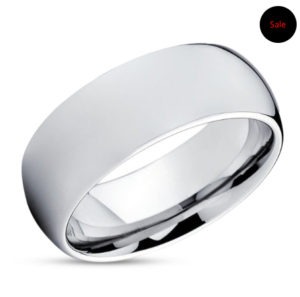
Image of a Cobalt Chrome mens wedding ring courtesy of cleancastingjewelry.com
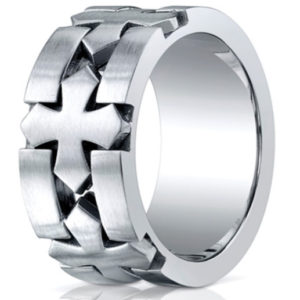
The image above shows a cobalt chromium alloy mens wedding ring. Image courtesy of 0scaring.com
Tungsten Carbide:
Tungsten carbide or “tungsten” as it is commonly called in the jewlery business is an alloy made of 85% Tungsten metal and the rest is Nickel. Although Nickel is notorious for causing bad reactions and allergies when it is mixed with other metals for applications in jewelry, this particular mixture is far less likely to cause allergic reactions. Tungsten is a very heavy mateial and it is also the hardest of all known metals.
Pros:
- 4 times harder than Titanium and twice as hard as steel, so it is very hard to scratch or dent Tungsten carbide.
- does not rust or tarnish
- has a nice look to it
- modestly priced
Cons:
- very heavy
- will crack as opposed to bending when put under excessive pressure
- not repairable if scratched or broken
Cons:
- may cause an allergic reaction due to nickel content
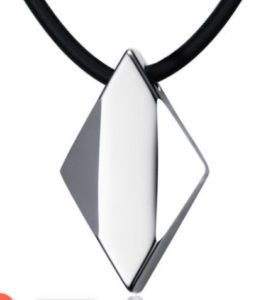
Image of a tungsten carbide pendant courtesy of justtungsten.com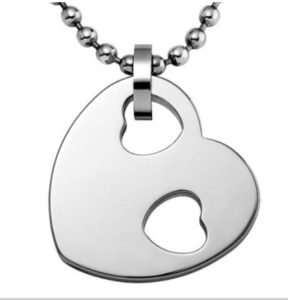
The image above is furnishd courtesy of tungstenworld.com
Image courtesy of tungstenjewelry.com
Carbon Fiber:
The material that we commonly call “Carbon Fiber” is simply a laminate material made up of layers of rayon fabric that have had the threads that constitute their mass baked in an oven to a high temperature without oxygen present. Baking rayon fibers in an airless oven “carbonizes” the threads, which are then woven into a very thick and stiff fabric. This thick and stiff carbonized rayon fabric is then sandwitched together in layers and bound up with some type of resin to produce the carbon fiber material we have all become familiar with. From a functional standpoint, carbon fiber is just an internally stiffened resin material, so jewelry made of carbon fiber behaves a lot like resin jewelry. Thus far, a few manufacturers offer jewelry made from carbon fiber, but nobody offers any mjolnir pendants made from this material as of the present.
Pros:
- light weight
- non-allergenic
- easy to repair small scuffs and chips with a bit of epoxy mixtur
- does not rot
- has a nice masculine look that is great for men
- great for wearing during exercising and sporting events because it is light weight and has an athletic sort of look to it
- prone to cracking under pressure
- works well for men at formal and semi-formal occasions
- modestly priced
- surprisingly strong and sturdy
Cons:
- prone to chipping
- will crack and not bend under heavy pressure
- has a strong masculine look that may not be a great choice for many women
- prone to tarnishing, fading, and cracking when exposed to excessive heat or cold
- prone to cracking, warping, slow disintegration, and discoloration if stored in direct sunlight for long peroids of time
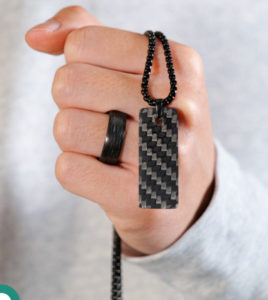
The image above shows a carbon fiber ring and necklace pendant that are for sale on the patrickadairdesigns.com website.
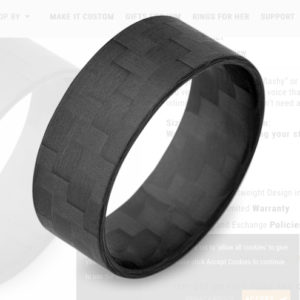
The ring seen above is a mens wedding band made from carbon fiber and acrylic resin. Carbon fiber wedding rings are growing in popularity for men because they are touted as being “manly bands” that have a strong masculine look. Looks aside, carbon fiber wedding bands offer some very real advantages for men who work with their hands: they do not conduct electricity, so men who work around electrify do not need to remove their wedding bands while working, and these types of rings do no stay compacted when crushed like more flexible metals do, which only creates furthe injury. Image courtesy of manlybands.com
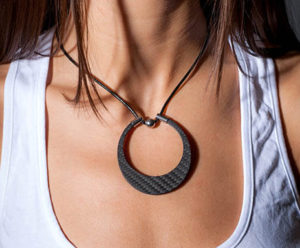
The image above shows a pendant made by cutting a carbon fiber sheet. Image courtesy of zakcode.eu
Conclusion:
I would certainly recommend getting a collection of mjolnir pendants to every National Socialist, Artaman, and Volkish person out there, and I would recommend wearing a pendant when out in public in order to signal your beliefs to like-minded people and to show your ancestral solidarity. True, there is a dizzying array of optoins out there to choose from when selecting a mjolnir pendant, but keep in mind, you do not have to limit yourself to wearing just one or two pendants, feel free to build a cool collection to punctuate any occasion.
I am also hoping that the section I wrote which discussed possibilities for making mjolnir pendants that nobody is doing at this time will inspire others to go forth and make cool mjolnir pendants from new materials.
Cheers!
James Rousse

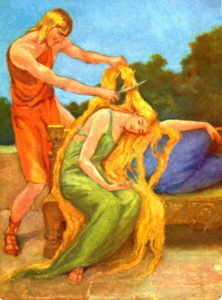
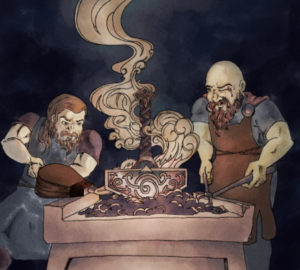
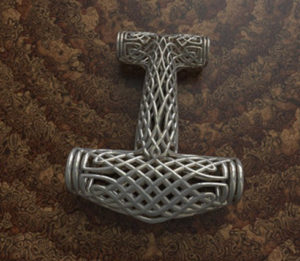
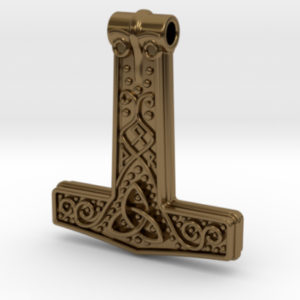
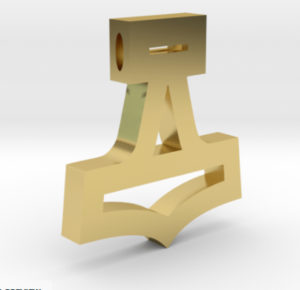
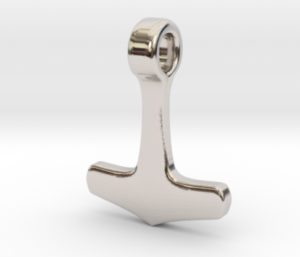
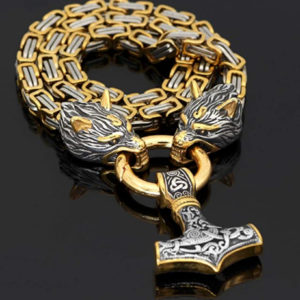
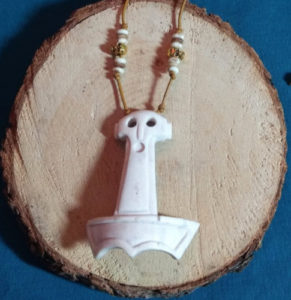
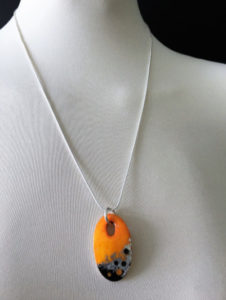
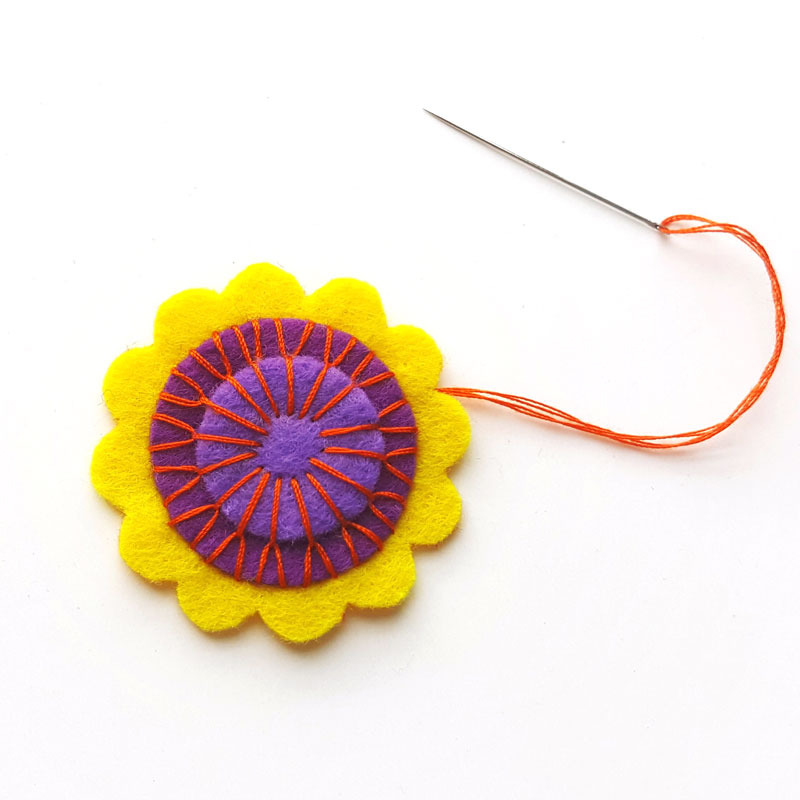
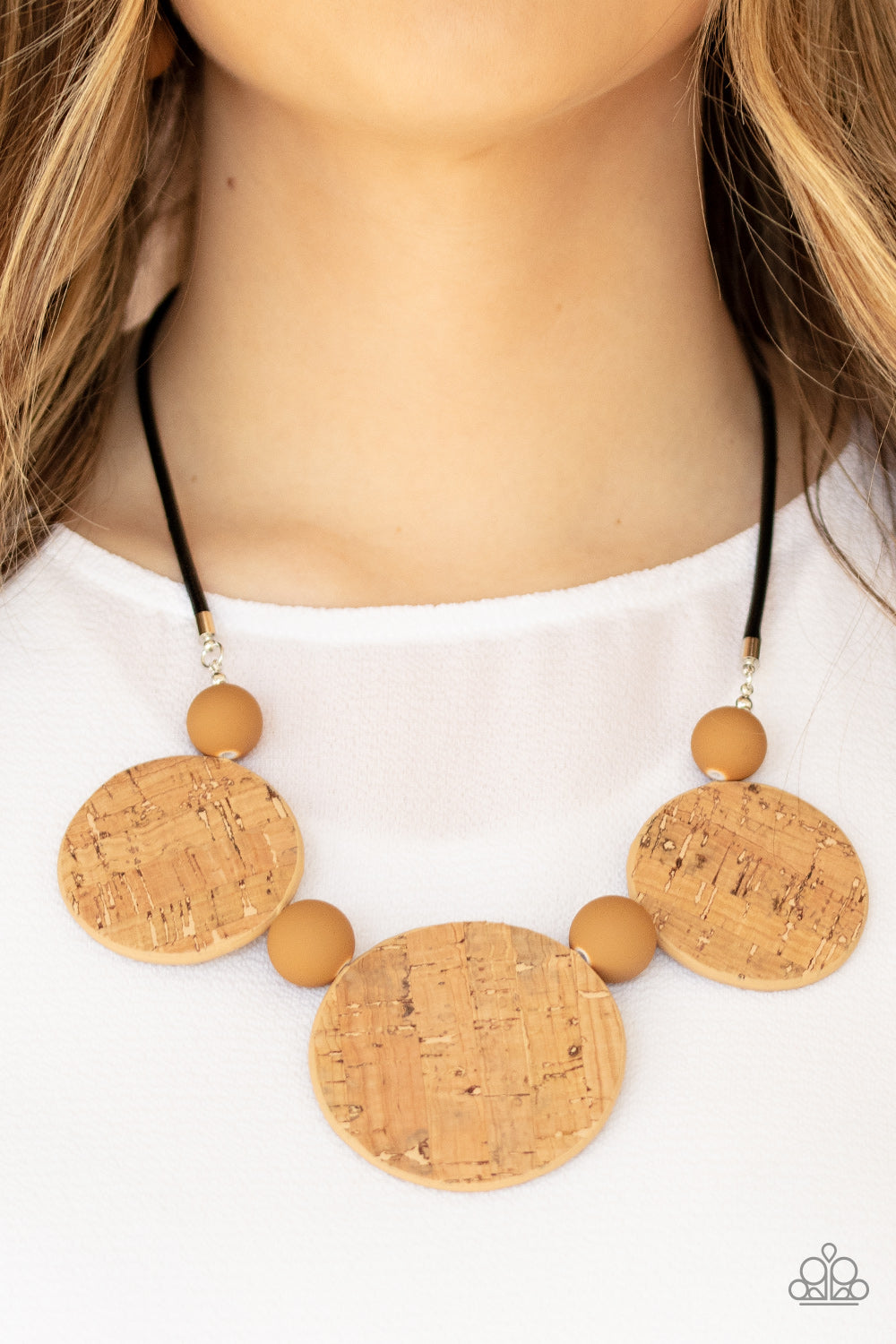
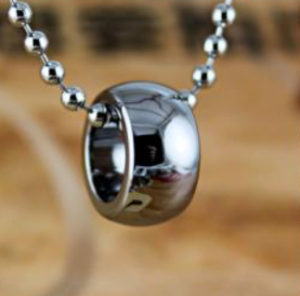






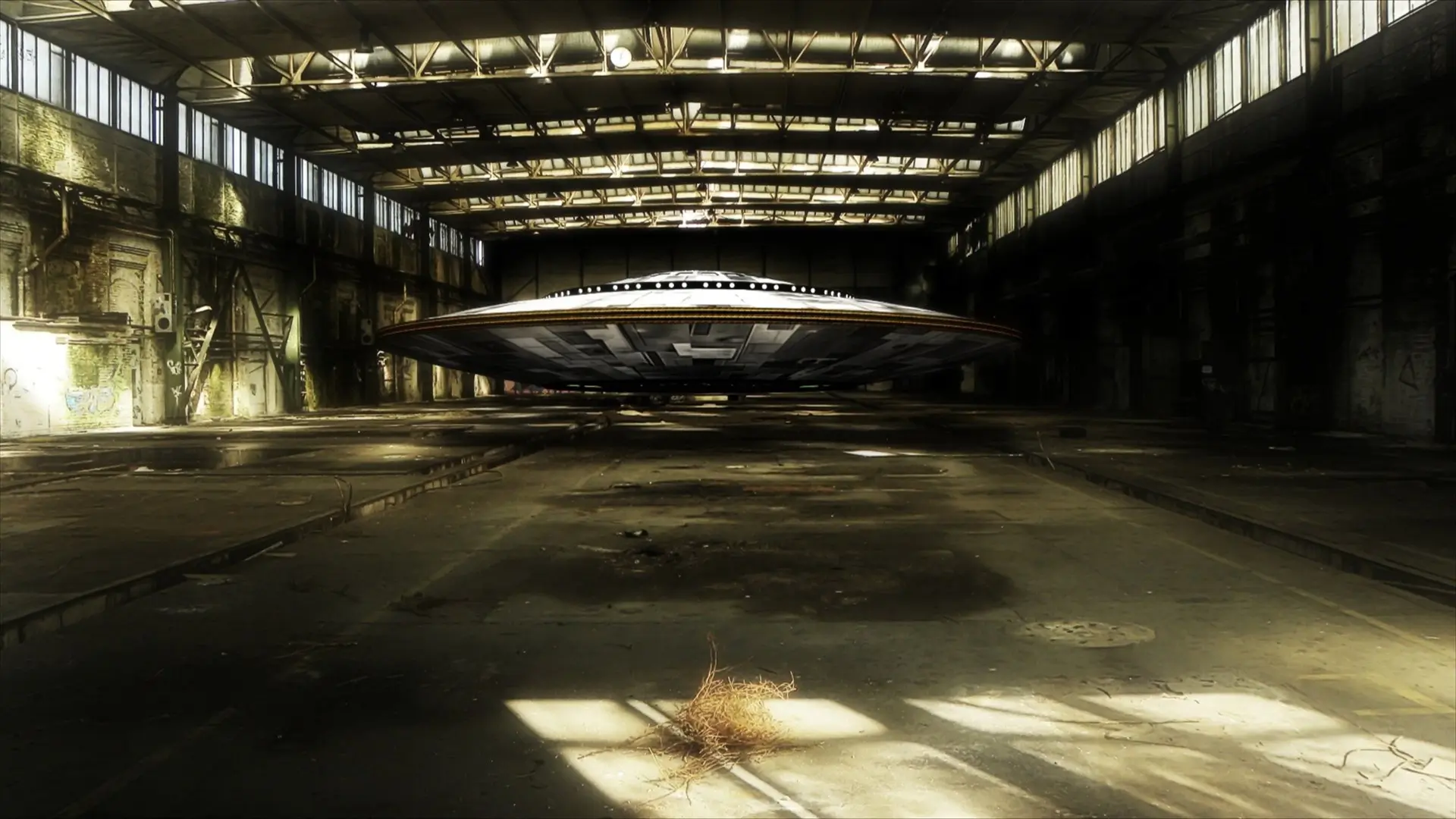





2 Responses
Informative article. Many can wear Mjolnir but only those that follow the All Father Odin are called. In the Aryan Nations, Sons Of Odin only the Gothi(priest) can wear a vulknut. I have several Mjolnir some from digs in Europe. Viking wear became trendy due to that dreadful “Vikings” show on TV. Most do not know that Odin is the god of Northern Europeans and heathens actually killed sexual degenerates. Thus, Aryan Nations, Sons Of Odin DO NOT allow non whites or homosexuals in our midst.
As an Odinist I agree With what you have stated. I wear a Thors Hammer necklace as a sign of my inward faith. Very good article.